#to have one standard naming convention is basically impossible
Text
What kind of saber is baxia anyway?
I love my bloodthirsty princess of a cursed blade, and in my heart of hearts i am nothing but a sword nerd, so i've been extremely fascinated by Baxia and how we know frustratingly little about what she actually looks like!
I mean, look at bichen, right?
Bichen in the donghua:

Bichen in the drama:

They're clearly not exactly the same. The scabbards are different, and the guards have a different shape. But these are recognizably different iterations on one theme, right? Thin jian with a white grip silver guard, light blue tassel and silver mounting accents on the scabbard.
Now this is baxia in the donghua:
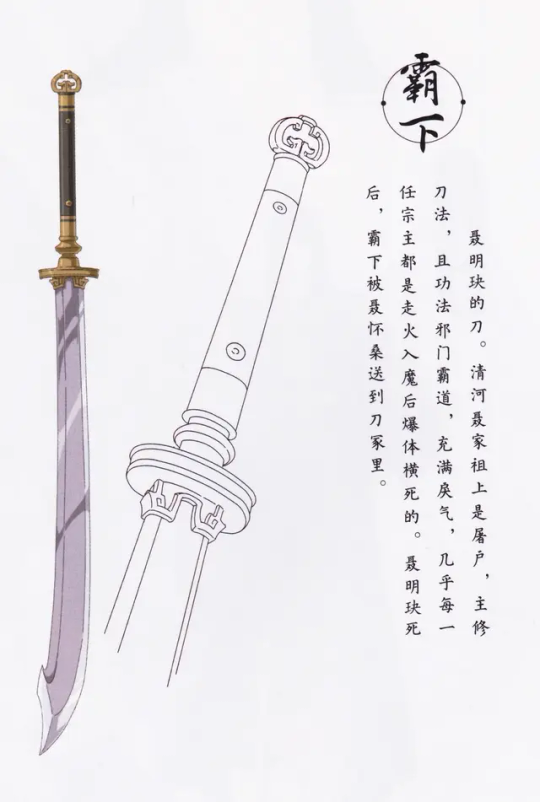
And baxia in the drama:

????????
THAT'S A COMPLTELY DIFFERENT WEAPON
it doesn't stop there either, the audio drama is kind enough to give us ANOTHER COMPLETELY DIFFERENT BAXIA

pretty! But how is that he same sword??
And when we go back to the novel, we get very little information on her appearance other than the fact that her blade is tinted red with all the blood she's absorbed. Which none of these designs incorporate.
This is not a dig on the designs itself, they're all quite gorgeous in their own right and i'm going to spend a while discussing all of them! Because isn't it fascinating how, since we know little about novel baxia beyond "saber" all of these designs ended up so different? What kinds of sabers are these, anyway?
So, a chinese aber, aka a "dao" (刀) just means a sword that has only one cutting side. As opposed to a jian, which has two.
You can see how that leaves a LOT of room for variaton.
I've actually seen some people get confused because Huaisang's saber in the untsmed is thin and quite straight, making it superficially resemble the jian more than drama!baxia, but it is still clearly a saber!

See? only one cutting blade!
This, to me looks a lot like a tang dynasty hengdao

credit to this blog for providing his image and being a great source for all this going forward.
TANGENT: during all this I found out the english wikipedia page for dao is WRONG! Ths is what they about the tang hengdao!

So that sounds like the hengdao was called that during the sui dynasty, but then, after that, started being called a peidao, right?
WRONG
I LOOKED AT THE SOURCE THEY USED AND IT SAYS THIS:

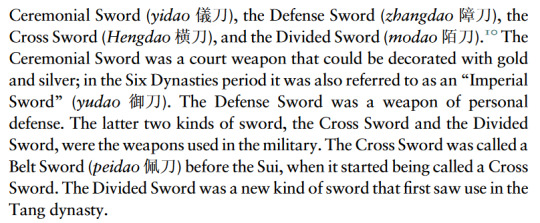
IT WAS CALLED THE PEIDOU UNTIL THE SUI DYNASTY, AT WHICH POINT IT WAS CALLED A HENGDAO. Which would carry over to the Tang dynasty. This was the source wikipedia linked! and it says something else than they say it does!
Anyone know how to edit a wikipedia article?
ANYWAY
BACK TO BAXIA
Since we're already at the drama, let's look at drama baxia: She's also straight! the general term for straight-backed saber is Zhibeidao, but that's a modern collector's term, and doesn't really say anything about which historical kind of saber baxia could be based on. Another meta i found on the drama nie sabers already went on some detail here.
I'm gonna expand on that a little: The kinds of historical straight-backed sabers we see resemble the hengdao a lot more than they do baxia. They don't go to their point as harsly as she does (she's basically a cleaver!) and they're all way skinnier.
No, my personal theory is that instead of being based on any kind of historical sword, drama!baxia is based on a Nandao.

I mean, come on, look at it!

Baxia!
The Nandao... isn't actually a historical sword. It was invented for Wushu forms. There's a really fascinating article about its conception, but that's why the swords in the images look a little thin and flimsy. Wushu swords are very flexible and light, they're dance props, not weapons to fight with. There are actual steel versions of Nandao, but they're recreations of the prop, not the other way around.
So That's one way in which Baxia differes from the Nandao: she's actually a real weapon. The other is that, as you can see above, the nandao has an S-shaped guard. Baxia doesn't. She's also much more elaborately decorated, of course. Because she's a princess.
Now: audio drama baxia!

This is much easier. with that flare at the tip?
Oh baby that's a niuweidao, all the way!

There are more sabers with that kind of curved handle, but the broad tip is really charcteristic of the niuweidao. The Niuweidao is also incredibly poplar in modern media, often portrayed as a historical sword, but it originated i nthe 19th century! And it was actually never used by the military!
That's right, the Niuweidao was pretty much exclusively a civilian weapon! That makes its use here anachronistic, but so is the nandao, and considering that the origin story of the Nie is that they use Dao intead of Jian because their ancestors were butchers, portraying them with a weapon historically reserved for rebels and common people instead of the imperial military is actually very on theme!
Finally, Donghua/Manhua baxia. These two designs are so similar I'm going to treat them as one and the same for now.

Unlike both previous baxias, The long handle makes it clear this baxia is a two-handed weapon, though Nie Mingjue is absolutely strong enough to wield her with one hand anyway. Normal rules don't count for cultivators.
Now, this is where things get tricky, because there are a lot of words for long two-handed sabers. And a lot of them are interchangable! This youtube video about the zhanmadao, one of the possible sabers this baxia could be based on, goes a little into just how confusing this can get. This kind of blade WAS actually in military use for many centuries, making it the most historically accurate of all the baxias. But because of that it also has several names and all of those names can also refer to different kinds of blades depending on what century we're in.
So here's our options: i'm going to dismiss the wodao and miandao, because these were explicitly based on japanese sword design, and as we can see manhua baxia has that very broad tip, so that won't work

(Example of a wodao. According to my sources Miaodao is really just the modern common term for the wodao, and the changdao, and certain kinds of zhanmadao... do you see how quickly this gets confusing?)
Next option: Zhanmadao.
Zhanmadao stands for "horse chopping saber" so... yeah they were anti-cavalry weapons. meant to be able to cut the legs and/or necks of horses. That definitely sounds like a weapon Nie Mingjue would wield. But if you watched that youtube video i linked above, you'll know the standardized Qing dinasty Zhanmadao looked very different from earlier versions. It was inspired by the japanese odachi, and more resembles the miandao than its ealrier heftier counteprarts.
Earlier Ming dynasty Zhanmadao on the other hand were... basically polearms. the great ming military blog spot, another wonderful source, says these are essentially a kind of podao/pudao (朴刀) which looked like this

Now that blade looks a lot like baxia, but the handle is honestly too long. Donghua!baxia straddles the line between sword an polearm a little, but while zhanmadao have been used to refer to both long-handled swords and polerarms, this was undeniably a polearm, not a sword.
If you want to know what researching this was like, I found a picture of this blade on pinterest-- labeled as a "two-handed scimitar"-- and the comment section was filled with people arguing about whether this was a Pudao, Wudao, Zhanmadao, Dadao, Guandao, or a japanese Nagita.
So... that's how it was going. This has kept me up until 2 AM multiple times.
However! Thanks to this article on the great ming military blog I found out there have historically been pudao blades with shorter handles!
Specifically, Ming dynasty military writer Cheng Ziyi created a modified version of the pudao to work with the Dan Fao Fa Xuan technixues-- aka technqiues for a two-handed saber, which would alter heavily influence Miaodao swordmanship-- thereby, as the article points out, essentially merging the cleaver-polearm type Zhanmadao with the later two-handed japanese-inspired design.

This is the illustration for the Wu Bei Yao Lue (武備要略) a Ming dynasty military manual
This blade shape in the illustration doesn't match Baxia exactly, but since it's a lengthened Pudao-like blade and we've seen above that those can match Donghua Baxia's shape, i'm gonna say that calling Baxia a Zhanmadao with a two-handed grip isn't all that innacurate!
However, because all of these terms are so intertwined, there are a dozen other things you could call her that would be about equally correct.
To show that, here's a lightning round of other potential Baxia candidates:
Dadao (大刀)

Which are generally one-handed and too short. However!
Another youtube video i found of someone training with a Zhanmadao that resembles baxia a little also calls it a "shuangshoudai dao" (雙手带 刀) shuangshou means two-handed, and while 雙手带 seems to refer to a longer handled weapon, when looking for a shuangshou dao or shuangshou dadao (双手大刀) we find a lot more baxia-resembling blades like here and here
I also found that, while the cleaver-like Dadao is strictly a product of the 20th centuy, since dadao just means big sword or big knife, it has been used to refer to loads of different weapons! Some people could've called the zhanmadao and pudao "dadao" during the Ming dynasty as well.
Another potential baxia candidate that mandarin mansion classifies as similar to the later dadao (though longer, as seen in the illustration below) is the "Kuanren Piandao"
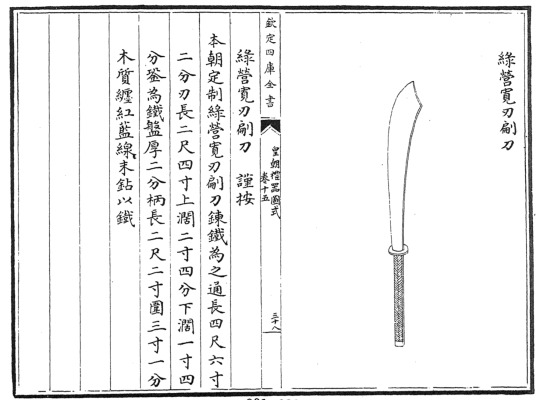
Which piqued my interest because this diagram classifying different tpye of Dao:
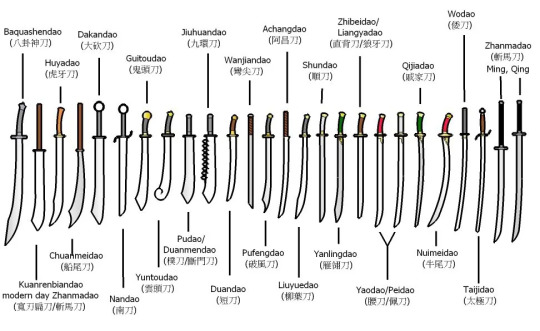
Claims that a Kuanrenbiandao (diferent spelling, same sword) is the same as a modern day Zhanmadao.
(So once again, all of these terms are interchangable)
Another opton Is the Chuanmeidao/Chuanweidao (船尾刀) below you can see a diagram, based on the Qing dynasty green standard army regulation, of blades all officially classified as types of "pudao"
The top middle is the Kuanren Piandao, and bottom left is the Chuanweidao.

Both of these have a lot of baxia-like qualities.
So there you go! live action baxia is based on a Nandao, audio drama baxia is based on a Niuweidao, and Manhua/donghua baxia is some kind of two-handed Zhanmadao/Pudao/Dadao depending on how you want to look at it.
I'm honestly surprised no one has made the creative decision to portray Baxia as a Jiuhuandao, aka 9 ringed broadsword yet.

I mean look at it! Incredibly imposing. Would make for a great Baxia imo. (@ upcoming mdzs manga and mobile game: take notes!)
#mdzs#mdzs meta#nie mingjue#baxia#cql#the untamed#long post#I HAVE SO MANY TABS OPEN. FEEL MY SUFFERING#I understand that asking a gigantic region with thousands of years of rich history and many different subcultures#to have one standard naming convention is basically impossible#But could they do it anyway? for me? 🥺#i also want to buy one of these... so bad#or even just a plastic trainer so i can practice the techniques#but i know that once i start buying swords i'm not gonna stop until my money runs out#Being a sword nerd is a very dangerous not phyisically but for your wallet
429 notes
·
View notes
Text
[Review & Recommended Watch] A Belated Look At MAL Expo Lite 2022 + MAL Academy Production I.G / Q&A with WIT STUDIO

Source: Screenshot from MAL Expo Stream, Hosted Feb 25, 2022
By: Peggy Sue Wood | @pswediting
MAL Expo Lite 2022 Review
MyAnimeList’s first-ever Expo was a fun experience, consisting of a small selection of online events that aired from February 17 to February 25, 2022. While the online anime convention boom in 2021 was a hit, 2022 saw a return to in-person events, leaving a void for those who preferred the digital space. However, online events such as Aniplex’s Online Fest and MAL’s first-ever convention remained a highlight for anime fans like myself. I appreciated being able to enjoy the panels, music, and anime from the comfort of my own home and without spending a lot of money. However, I was disappointed to see that, like many other online conventions, MAL quickly removed the streams, making it impossible for viewers to watch at a more convenient time.
The MAL Expo offered a variety of art-related events, musical performances, and yearbook activities. Still, what really stood out to me were the MAL Anime Academy talks with Production I.G. and WIT Studio. The event featured Chief Animation Director Takayuki Goto and Executive Producer Gunji Mikio from Production I.G. discussing the animation process at their company using the Legend of the Galactic Heroes: Die Neue These and President George Wada from WIT Studio hosting a Q&A session. I found both additions to be informative and educational, which meant that I spent a few hours in the YouTube rabbit hole seekingout a captured live-stream of those two back-to-back events that you can view below.
The performances were what I would consider standard for this kind of small-scale convention. Though, perhaps because of MAL’s name recognition and present contracts with streaming services like Crunchyroll, the performances were of a higher standard than most small-scale events like this one. Overall, I found the Expo very entertaining and a welcomed addition to MAL’s history.
One negative aspect of the event was that it lacked the same polished feel that many others in the digital convention space tend to have. The hosts frequently read from print-out scripts when a prompter could have been used. I mean, my sister purchased an inexpensive one on Amazon a while ago that basically was an app on her phone and a projector for the phone screen, so I imagine that a studio with enough backing to bring in prominent studios like Production I.G. and WIT Studio could have afforded at least that. Additionally, I was disappointed with the amount of shopping and advertisements present during the streams as it made it feel like MAL was struggling for content, which should not be the case.
Overall, 3/5. I think that MAL Expo, should it happen again this year, should look to Aniplex Online Fest for guidance on formatting. Rather than stretch things out for days, they could have gathered their events and press them into a single, long stream over the course of a day or two, and fill any holes in the stream with a few anime episodes or short marathons with permissions from licence holders. The event also does not have to be live, but rather pre-recorded with a set release schedule. Moreover, anime marathons could be used to advertise MAL’s feature of streaming Crunchyroll and other licensed content through their website.
Content Share: MAL Academy Production I.G / WIT STUDIO
youtube
Title: Q & A with Industry Professionals Takayuki Goto and George Wada at MAL Expo 2022 | Source: https://youtu.be/Io1XGJYiJ1g
The streamer who recorded the particular section of the MAL Expo Live-Stream that I’m referring to is AniHive. While I haven’t watched a lot of their content yet, they seem to have a diverse range of anime-focused videos, including reviews, amv snippets, and top 10 listicles. From what I’ve seen so far, it’s worth checking them out and keeping an eye on their future content, especially since their editing and recording skills appear to be consistently improving over time.
It’s important to remember that for stream captures like this to remain on the internet, they need to include commentary that is transformative to the initial media. This helps avoid issues like copyright strikes and take-downs. Essentailly, by adding commentary and insights to these streams, one can help ensure their longevity online.
As such, there are a lot of additions to this stream in the commentary and breaks. I want to point out that the MAL Academy with Production I.G starts at around the 30-minute mark, while the WIT STUDIO Q&A begins at approximately the 1 hour and 55-minute mark.
I hope you all enjoy!
—
Written by Peggy Sue Wood and Edited using ChatGPT.
0 notes
Text
the linguistics of dr. stone...
Alright so, I think from a worldbuilding, specifically an anthropology standpoint, Dr. Stone is brilliant. Inagaki and Boichi obviously put a lot of thought into how they represented Ishigami Village and Treasure Island, the two places have their own distinct cultures, hierarchies, traditions, clothes, etc, even just the ‘standard appearance’ for members of the two settlements is distinct. Of course, they also have their commonalities, both settlements are ‘water tribes’, skilling in fishing and boating, both have women warriors who kick ass (Kohaku and Kirisame my beloveds), both have a patrilineal leadership system, and both, for some completely bullshit reason, speak Japanese.
One element Dr. Stone’s worldbuilding seems to fall through on, (read: completely ignore) is linguistics. Ishigami Village and Treasure Island were left alone to develop for 3700 years and yet somehow still speak the exact same version of Japanese Senku, Gen and the others do? That's insane. The common vocabulary used by a group of native language speakers can depend on a million things like age, gender, social class, religion, and pop-culture, and can change on a yearly basis. Things like grammar and syntax are also subject to change, whilst they take longer to do so, they absolutely do, and often change a lot over the course of one language’s history. To give an example, the English of around 3700 years ago was the stuff of Shakespeare and the King James Bible, just beginning to shift into the Modern English I’m typing this post in now and all but abandoning most features of Middle English. (Interestingly enough, Japanese also went through a similar shift from its Middle Form to its Modern Form in the 1600’s around the same time English did).
Basically what I’m getting at is if we go on the assumption that Ishigami Village and Treasure Island both continued to speak Japanese for the 3700 years the rest of the world was petrified, the version of Japanese they would speak would be as about as comprehensible to Senku and the rest of the modern timers as Shakespearean English is to me, which is to say, just enough to understand basic spoken sentences or slightly longer written texts but not much more, and the inverse would obviously also apply to the villagers and islanders trying to understand Senku and his pals, who, from their perspective, would be speaking an extremely archaic form of their language.
Two issues, however, arise with this assumption. The first is that Ishigami Village and Treasure Island would even speak Japanese in the first place. The second is that if they both did, they would somehow both develop a version of Japanese that is identical to the other despite these settlements never interacting.
So let's tackle the second issue first. Even if we go with the assumption that both Treasure Island and Ishigami Village speak Japanese, (Which is a really freaking dumb assumption), it is completely impossible that the version of Japanese each group individually developed over the course of 3700 would just so happen to be similar enough that its members have no issue talking to each other when they finally make contact. This is reflected a tiny bit in the manga itself, with the residents of Ishigami Village all taking their names from the Japanese or English words for gems and minerals, and the Treasure Island having the custom of naming babies after the first thing they set their eyes upon, usually using the Japanese word for that thing, with Amaryllis and Soyuz being exceptions. However, in reality, the language used by the two settlements would have a lot more differentiation than just naming conventions. 3700 years is a long time, especially for a vocabulary, and seeing as the two settlements have different ways of life, cultures, belief systems, and populations its most likely that they would use completely different words for the same thing (see: U.K English ‘bum bag’ and American English ‘fanny pack’), use the same word for two separate things (see: U.K English vs American English use of ‘football’), and just have completely new words for stuff the other group wouldn’t understand or recognise (see: neither U.K nor American English speakers having any idea what Australians mean by ‘drongos’), and as such, whilst the two dialects would still probably hold a level of mutual intelligibility there’s no way they’d be similar enough for the villagers and islanders to never have moments of “‘What the heck does that mean?” or “What did you just say?” .
Whether or not the two dialects of Japanese developed by the settlements would have similar grammatical structures is a trickier question. 3700 years isn't as long for a grammar system as it is for a vocabulary but it’s a decent chunk of time, and again, based upon the geographical distance between Ishigami Village and Treasure Island, it seems unlikely to me that the two dialects would share an identical grammar system, or both somehow independently develop a unique grammar system that just so happens to be mutually intelligible enough with the other to cause basically no confusion when conversing. Hell, Standard American English speakers get confused by the grammatical structure of African American Vernacular English all the time and those two dialects share a far greater geographical proximity and level of intermingling than Ishigami Village and Treasure Island do.
However, we can ignore the issue of how and why the two settlements use nearly identical forms of Japanese despite having no contact with each other or any other Japanese speakers for 3700 years by asking the even more important question; WHY THE FUCK DO THEY SPEAK JAPANESE AT ALL. Of course I understand why from a meta perspective, Inagaki isn’t a linguistics enthusiast and whilst he obviously has at least some interest in anthropology it’s clear his main passion is science, which makes sense, Dr. Stone is a manga about science, not language after all, and by having both Ishigami Village and Treasure Island not only speak Japanese, but the same kind of Japanese as each other and Senku, a lot of time and effort is saved on his part. I don’t begrudge Inagaki this nor do I think it makes him a ‘bad’ or ‘lazy’ writer, Conlangs are hard and writing a character learning a new language is arguably even harder, so yeah, it makes sense to me from a narrative perspective to have everyone all just use Standard Japanese.. In universe though? It makes zero fucking sense at all.
English, generally American English, is the official working language (known as a ‘lingua franca’) aboard the International Space Station, however as of 2011 the Russian Soyuz spacecraft is the only way of reaching the ISS and since its controls are entirely in Russian, knowing the language is a requirement for all astro/cosmonauts. Aboard the ISS there were 3 Russian cosmonauts, who presumably already spoke Russian and who we canonically see use English, 2 astronauts, the American Connie who, again, we see use English, and also presumably has a grasp of Russian, and the Japanese Byakuya, the only assumed trilingual of the group, who canonically uses Japanese and English, and also just like Connie, would need to have a grasp of Russia to even become an astronaut in the first place. Lilian is of course the outlier here, whilst we do, as of this absolute hell year, have examples of super rich space tourists, we don’t of ones who actually boarded the ISS. I’m going to assume that Lilian only spoke English, seeing as she herself was not an astronaut, and even if she had learned Russian it’s not as if she’d have the authorization or technical skill to carry out operations on the Soyuz or ISS.
So basically, English is the one language spoken by all of these people, and Russian is known by 5 of the 6, Japanese however is native to only 1 member of the group. Now I of course assume that all 6 of the ISS squad became proficient in all 3 languages, as they had little to do for entertainment on Treasure Island other than listen to Lilian sing or play games, and I’m also going to make the assumption that their children and grandchildren were trilingual too, with Russian probably being most commonly used as 3 of the 6 were native speakers, compared to the 2 native English speakers and 1 native Japanese speaker. However, over time, multilingual groups in consistent communication with each other eventually form a Pidgin, a sort of simplistic language that draws upon the vocabulary, syntax, and grammar of 2 or more ‘parent languages’ for the purpose of trade, diplomacy, or because the two language groups have found themselves stuck together. When a Pidgin begins to become more sophisticated in structure and is taught to and used by children as a native first language, it becomes a Creole, its own fully developed language distinct from, but often still closely related to, its ‘parent languages’. (The commonly believed most natively spoken Creole Language in the world is Haitian, drawing from French, Spanish, English, Portuguese, West African and Indigenous Caribbean Languages and having between 9 and 10 million native speakers)
What I’m getting at is, the original ISS 6, if not their kids or grandkids, likely would’ve formed a Japanese-English-Russian Pidgin at some point. I’m not a linguistic anthropologist or language historian but if I had to guess I’d assume this ‘ISS Pidgin’ would borrow vocabulary and grammatical structure from all 3 languages, perhaps more so Russian as that was the most natively spoken language amongst the ISS squad. Additionally, over time, future generations would’ve been taught the ISS Pidgin in place of learning the 3 parent languages individually, transforming it into its own Creole. This ISS Creole would then also most likely go on to develop two distinct dialects in Ishigami Village and Treasure Island, dialects that would definitely share a decent enough degree of mutual intelligibility but, depending on when exactly the groups split off, probably wouldn’t allow for complex discussion without pausing to explain vocabulary and syntactical features to each other for clarification, just like how if spoke in my natural Scottish English, slang and unique grammatical forms and all, to an native Australian English speaker, they’d have to ask me to explain what I just said to them for a decent part of the conversation, and vice versa.
Now I see you all getting ready to type out your long ass replies and I’m here to let you know that yes I am going to address the elephant in the room. The 100 Tales are in Japanese, specifically, the Standard Modern Japanese Byakuya uses natively. Whilst no one other than Priestesses ever seem to learn the full 100 Tales as far as we can tell, it is canon that they will tell some of the tales to the rest of the settlement, to pass along the knowledge shared in the stories. As such, the 100 Tales essentially function as an oral tradition, (also referred to as an ‘oral history’). Now generally, an oral tradition will develop as a language does, the content of the story remaining the same, but the wording often changing as older forms on the language it belongs to become archaic and never forms are adopted en masse. In the scenario where there is a culturally important written text, rather than an oral tradition, such as the Quran, the language will often remain more similar to the language of that text. As such, Classical Arabic, the language of the Quran, shares its syntax, morphology, and phonology almost wholesale with Modern Standard Arabic, with vocabulary and different forms of casual and formal registers being what differentiates the two. As oral traditions do not have a written text to adhere to, their language is more free to develop further away from the original version. This is not to say that oral traditions are less accurate or not as historically relevant as written text, as they are often shared amongst a group and painstaking detail is taken to ensure it is memorized correctly and the story goes unaltered, even if the language the story is told in changes over the centuries. Drawing from this, it can be assumed that the 100 Tales could have been translated into my hypothetical ISS Creole and its 2 dialects over the course of 3700 years and still transmit all the original information Byakuya put in them. Even if the Tales remained unchanged and were passed down in their original Japanese form, it’s entirely likely that the Villagers and Islanders learnt only the Japanese used in the Tales and still employed their own separate language. Like how many Muslim communities all over the world know enough Arabic to understand the Quran and to pray, but still communicate to each to other in English, Urdu, Farsi, etc.
The TL;DR of this post is I want an AU where Ishigami Village speaks a totally different fucking language from Senku and he and the other modern people have to go through the process of learning that language so that they can communicate effectively with the Villagers (and later Islanders), using alot of creative pictionary and miming in the mean time. Additionally when the people from Ishigami Village and Treasure Island interact for the first time I want them to have the total confusion of ‘I technically got the gist of what you just said but understand very little of the words you actually used in the context you use them’, also dumb arguments about what the correct name for something is like how U.K English speakers and American English speakers argue about what a ‘biscuit’ actually is.
(before you come at me about ‘suspension of disbelief’ and ‘oh so you can ignore them all being descended from 6 ppl but draw the line at speaking japanese?’ pls consider: this post is just me, a linguistics nerd, having fun and is not supposed to be a Serious Critique TM of dr. stone. i get inagaki has the villagers and islanders use japanese its the same reason he doesnt write xeno and stan’s dialogue exclusively in english, so readers and understand wtf is going on, i just made this post bc i thought it’d be interesting to dive into what language could look like for ishigami village and treasure island)
#Dr. Stone#riichiro inagaki#boichi#shounen jump#ishigamu senku#plz give this notes its over 2k#og post //#long post#linguistics#i would put a read more on this but consider: i want to subject everyone to my opinions
23 notes
·
View notes
Text
Lilith
History:
Lilith was the original Eve, created from the same soil as Adam. Her name comes from the Babylonian “Lilitu” meaning “female demon” or “wind spirit”. When Adam insisted that he should be dominant, Lilith dared to question him. After all, they were crafted from the same Earth. She wished only to be equal, but was demonized for this. She was, thus, cast out of Eden. Allegedly, she created thousands of demon spawn and devoured infants by the bucketful. These accusations are falsehoods, crafted by those fearful of her righteous autonomy. Any havoc Lilith wrought was only out of woundedness, like the actions of a feral animal. She was shunned for speaking truth.
The “me too” movement is an expression of Lilith, where women show solidarity for the abuses they’ve suffered in silence. It is Lilith who exposes patriarchal corruption. Women become likened to banshees when they dare show rage. However, it would be limited to interpret Lilith only from the perspective of gender-based conflict. She is pure gut-instinct and extends far beyond sexual independence.
Lilith represents one’s ability to say “no” to what doesn’t feel right. She is pure root-chakra wisdom. The knowledge of the earth, muddy and messy. In one’s chart, she shows where you can become in-touch with your own body-wisdom. It’s this feeling in your stomach that says “heck yes!!!” or “this person makes my skin crawl.” Such intuition doesn’t align with left-brained, scientific modes of analysis.
The Signs/Houses:
Much like the asteroid chiron, Lilith represents a rejection wound in one’s chart. It’s where you speak your truth and no one wants to hear it. You put your heart on the line, but your desire for connection made someone cringe. You state your needs, and people ask “why do you have to be so difficult???” All you want is for someone to see the ferocious warmth beneath your intensity.
*if you have Lilith aspecting a planet, read the description for the sign it rules. Ex: sun would be Leo, Mercury would be Virgo or Gemini*
Aries/1st house: Daring to express oneself. The human embodiment of Lilith. Carnal. Someone who is known for butting heads with others. Notorious warrior. Fighting for the underdog is a part of one’s identity. Poster-boy of rejection wounds. Someone who feels like they’re “too much”, either bottling themselves up or living up to the expectation. Starting fights and then running to lick your wounds. Riling people up to get the negative attention you’re accustomed to. Truthfully, desiring authentic love that’s not based on filtering your personality into something more palatable.
Taurus/2nd house: someone who was told their desires are wrong. Being told you’re gluttonous for taking care of basic needs. Primal, all-consuming hunger. Eating disorders and shameful indulgence. A desire to consume one thing until you get sick of it. Ferociously guarding personal belongings and beliefs. Hoarding. A strong need to listing to one’s body, even if what it asks for doesn’t match conventional wisdom. Bullied for one’s weight. Earthly intuition. An unadulterated love for oneself that makes others uncomfortable. Intoxicatingly stubborn. Harsh & deep-set standards of morality.
Gemini/3rd house: saying things about people that hit a little too close to home. The thought process is primal. Knowing why people say the things they say. Reading people like a book. Ruthlessly pointing out falsehoods. Lilith is the trickster here, wearing many masks. Infamous for being inconsistent. Obsession with social dynamics, due to past rejection by “the tribe”. An outcast during school years. Extreme fear of missing out. Hiding taboo thoughts for fear of rejection. Unable to learn in a conventional fashion. Reading about the occult, depth psychology, myths, and anything else focusing on the core of human nature.
Cancer/4th house: the mother as an untamable Lilith figure. Standing up for one’s relatives. Someone with a dubious past. Mother was deemed insane or illogical. Black sheep. Feral obsession with comfort. Finding comfort in brutal honesty and ruthless emotional depth. Being deemed “impossible to live with”. High standard of living. Needing to set boundaries with one’s family and living situation. Controversial self-care. Knowing what truly matters. Fierce protector of the young and helpless. Savage goddess of the hearth. Periodic seclusion within one’s cave. Emotions take on a life of their own, going in bestial rampages.
Leo/5th house: Being ruthless becomes a game. The sin of unfiltered selfhood, becoming demonized for having fun. Toying with people’s hearts. Love/hate relationships. Compulsive validation needs. Hobbies may be taboo or the parents could’ve encouraged them to keep to themselves. Flames of desire emanate, pulsing like pyrotechnics. Rejected during childhood games. If they have kids, they’re likely the brutally honest sort. Children provide surprising bits of wisdom. This is someone who feels guilt for wanting to live a little. Unfiltered emotional expression can be too much for others. Heart swells at the slightest provocation. Needs to do what is simply in their nature, as those who matter will honor their authenticity.
Virgo/6th house: Compulsive organizational systems that seem illogical to others. Angry cleaning. Power of the gut-brain connection. Nature’s way of healing itself, clashing with the business of modern medicine. Disagreeable coworkers, or disagreeing with them yourself. Infamous at your place of work. The intestines strongly reject certain foods, so that you have to listen carefully. The diet may fluctuate daily. Acquired knowledge about nutrition and health may be of the controversial variety (carnivore diet, intuitive medicine, low oxalates, etc). Routines which may appear feral, but ground one in their body. People may take your high strandards personally, as they don’t know how to set boundaries themselves. A knot in your stomach tells you if something isn’t good for you.
Libra/7th house: Others are a mirror for the part of you that possesses unabated self-knowledge. Attracted to people ruled by irrational instinct. Must be careful to set clear boundaries in interactions with others. Compulsive need to interact and form partnerships, which may overwhelm others. Wild charm. Demonizing others. Wanting someone to teach you how to think for yourself. Partner helps you return to & nourish your body. Guttural wisdom exchanged in daily interactions. Best friend is someone incredibly grounded, who lives authentically. You demonize or idolize those who think for themselves.
Scorpio/8th house: psychoanalyzing others before they can do they same to you. A lifestyle that allows for a great deal of secrecy. Obscure & impenetrable. Unreavealing of cavernous depths of feeling, because they fear no one is brave enough to explore these shadows. Making people uncomfortable by purging every secret at once. Being abandoned once you reveal your true self. People offering “gifts” with treacherous strings attached. Unhealthy relationship dynamics- one person is running while the other is chasing. Being stalked or doing the stalking. Unearthing other’s rejection wounds. Shamanic. Concealed impulses. Instinctual need for closeness, where everything is shared. Their “soul mate” is someone ruthless.
Sagittarius/9th house: Too much to handle. Cycles of binging and purging. Living a life of excess. May attract questionable travel companions. Worldview is based on sharing hard truths to all who will listen. This is not someone who minces their words, though they’ve been told time and time again to keep their mouths shut. Their opinions are of the controversial variety, though they are rarely wrong. Arguments are a playground. Saying “no” to the religious doctrine pushed upon you as a child. A skeptic, because they know better in their gut. Higher education brings out compulsive tendencies. May confront teachers & all traditional knowledge. Tearing self-proclaimed gurus down with sharp wit.
Capricorn/10th house: Social pariah. Sex symbol. Businesses that involve female empowerment. Glitzy. Destined to become infamous. Dense and frenzied energy remains when you leave the room. Man-eater. Insatiable need for recognition, tearing one’s way through the corporate ladder. Symbol of truth. Breaking out of the box society has placed you in. The father/dominant parent may have been a “difficult” person. Lack of respect for false or corrupt authority. Innate power. “Bad cop”. Sticking it to the man. Fear of subordination. Intimidating competence and confidence. Cimmerian. Public symbol of authenticity. Honest evaluation of societal structures. Organized chaos.
Aquarius/11th house: Friendship isn’t taken lightly. May associate with controversial people. Freaks. Love/hate relationship towards humanity. Scaring aqaintances. Inundating society with knowledge they’re not yet ready for. Untethered. Jealousy towards those who meld into groups, causing them to further isolate. A reject, estranged from reality. Diabolical. Deep desire to be included. Obsession with what everyone else is doing. Violent subcultures. Strangers invading the native’s personal space, or vice versa. Electric compulsions, jolting the native out of old ways of being. These sudden consciousness shifts perturb others. Radical awareness of the body. They’ve been told to keep their visions of the future to themselves. The divine feminine is crowned in a fluorescent blue halo, lifted above the earth by undulating nimbus clouds.
Pisces/12th house: Beastial dreamscape. The Feminine Wild is both feared and revered. Fantasies of standing up for yourself. Trouble accessing your instinctive and earthy side. Conduit for collective delirium. Dissolution. Substance abuse. Ignoring instinct is your self-undoing. Surrendering autonomy. Deemed too hysterical, sensitive, and irresponsible. Freedom comes from claiming spiritual dominion. Knowing what your dreams and subconscious yearnings mean, becoming defensive when people dismiss your interpretations. Crawling out of your skin. Arcane knowledge via escapism. Odd methods of psychological mending.

9 notes
·
View notes
Text
Notes on some Rare Economic Systems (That Do Not Work)
1.
A little more than two hundred years ago, the state of Kezaria was rapidly changing, but straining against a patchwork of antiquated laws supported by a corrupt government. The Kezarian parliament was filled with representatives of rotten boroughs, its aristocracy refused to endorse any kind of political reform, and its population was moving from the countryside to the cities as enclosures on the one hand and the growth of the urban economy on the other conspired to convert the country from an agrarian economy to an industrial one. Eventually, protests broke out which threatened to become a real revolution. Terrified of the consequences of such a revolution, the State Council of Kezaria forced through a series of reforms that included, among its provisions, a regular cash disbursement for the relief of the poor. As all this happened before Speenhamland, a prejudice against such a program had not yet been established in Kezaria, and the State Council was desperate for anything that would keep the government from being overthrown.
Incidentally, it worked, and though initially considered a minor provision, direct poverty relief became a cornerstone of Kezarian government. As the country moved further in a socialist direction–now through gradual reform aided by democracy, rather than revolution or the threat of revolution–this provision was expanded, and eventually enshrined in the Kezarian constitution. But some thinkers still considered the economic system fundamentally unjust; redistribution, they said, was not enough. It was still possible that wealth should be unequally amassed, that the resources of each citizen should be too different in magnitude, and therefore some would have unelected power over their fellows; and a state that was a democracy worthy of the name should make all its citizens equal in matters of money as well as law. And so in due course, all income *outside of* the Kezarian basic income was banned.
This is the Kezarian system as it stands today: each month, an account in every citizen’s name is reset to 2,000 Kezarian lions–although the lion no longer functions as a true currency, the name is retained for the sake of historical continuity. The lion may be spent, but not accumulated: an excess of lions, as well as a dearth, is wiped out at the end of each calendar month. As accounts may be held only by natural persons, no business has a single swan (the Kezarian cent) to its name, except what its managers and executives might pool of their common monthly resources. Transaction taxes are very high–as much as 20 or 30 percent of any purchase–in order to keep the lion in circulation, but nobody much minds, as they are not really losing any money in the long run.
The inconvertibility of the lion means that, naturally, tourism is nearly nonexistent in Kezaria, and all imports must be purchased by the state and imported using its foreign currency reserves. But the Kezarians seem content with their system, for they can look around at their neighbors and friends and politicians–all the people who *really* matter, after all–and be confident that no one is doing much better, or much worse, than them.
2.
Miskando is perhaps unique in the world for being a modern, industrialized, and prosperous gift economy.
Miskando has few laws, not because its people are of an especially libertarian bent, but because informal rules in Miskandese culture to an unusual degree. Whereas the British have no need of a written constitution, because convention governs their parliament so strictly, the Miskandese have little need of written laws, because contravening the rules of polite society is unthinkable. Such behavior puts one in the same category as a child, imbecile, or foreigner; and if you truly do not know how to behave in a given situation, well, Miskandese bookshops do a brisk trade in manuals of etiquette, and the most popular section of the newspapers is invariably the one given over entirely to advice columns.
The commercial storefront in Miskando is in fact an evolution of the private home; as such, there isn’t a strict distinction between “house” and “shop,” and one observes the niceties of calling on a friend or acquaintance when one enters a shop, even if the proprietor is totally unknown to them. If you need something–a new hat, perhaps, or a week’s worth of groceries–the custom is that you wander into a shop and look about for a little while. The shopkeeper or the clerk will ask you if they can help; you must refuse at least once. When they insist (as they invariably will), you will begrudingly admit that there are one or two things you might want, and after a little back-and-forth and some polite chit-chat about the weather, you will gather the items on your list, enquire after your interlocutor’s health and the health of their children, and then depart.
The provision of services, even complex ongoing services, is furnished in much the same way. A bilateral relationship must be carefully cultivated between members of two different firms; as a rule, favors are exchanged, rather than contracts being made, and are never quite repaid fully: to do so would be to formally disobligate someone, and thus to end your relationship with them. This is seen as a terrible snub when it occurs between individuals, and when it occurs between businesses is usually due to one party incurring the other’s greatest displeasure
.Outsiders attempting to do business in Miskando have generally found the process bewildering, even those from politeness-heavy societies. The Miskandese, for their part, have adapted fairly well to commerce with other nations; after all, if they have need of hard currency, they usually have a friend who owes them a favor that they can ask.
3.
In Gharat, all money is in the form of immense bronze pillars.
Long ago, it is said, the people of Gharat exchanged certain standardized, useful goods, like knives or wool cloth, whose value was widely agreed upon. These eventually gave way to the ancient Gharat knife-currency, a chunk of bronze of a fixed weight whose resemblance to the older medium of exchange was only passing. The real value was in the metal itself; and because of its weight, large amounts of these heavy pieces were often bound together to prevent theft.
One day, a thoughtful merchant had the bright idea of simply melting all his bronze into one enormous mass, which he could simply leave outside his house–after all, it was impossible to steal. Many others began to follow suit, and some began to craft the displays of their wealth into more elaborate shapes, and eventually, the tradition of the bronze pillar currency was enshrined. It didn’t matter that it couldn’t be transported; after all, the metal wasn’t *used* for anything anymore–the Gharati had by this time moved on to iron tools. And (so the Gharati held) assiduous recordkeeping meant that it was always widely known who owned what pillar, even if the pillar in question happened to be three provinces over.
The centralization of the Gharati nation in the 18th and 19th century and the codification of Gharati customary law necessitated the establishment of a centralized record of ownership of the pillars; and it was eventually discovered, to the horror of the nation’s leaders, that the records of ownership were, in fact, a contradictory mess. They *could*, perhaps, be sorted out, and the spurious claims distinguished from the genuine ones, but to do so would be to devastate the wealth of the nation: multiple ownership of the same pillars more than quintupled the country’s GDP, with some particularly contested pillars being owned by as many as fifty people. Perhaps they could keep the situation a secret; but if word ever got out, they feared, there would be chaos and riots as a result.
The solution came from Gharati religious law, which had always been rather more concerned with metaphysical matters over practical ones. One object, the scriptures said, might really be two, depending on how you look at it; so the Gharati lawmakers simply proclaimed all claims of ownership that had existed on a certain date, a few years previous, to be valid; and any *appearance* that one pillar might be owned by more than one person was, in fact, an illusion of the material world. Really, these were multiple pillars that happened to be superimposed on one another. They might *literally* be made of the same particles of metal, but they were *conceptually* distinct. There was some grumbling when this was announced–but no one wanted to risk losing the lion’s share of their net worth overnight, so it was quickly accepted.
Yet despite proposals, the Gharati have never made the shift entirely to a pillar-backed paper currency, or to a fiat currency entirely. After all, they say, money ought to be something *real.* A bronze pillar has mass and heft; and thus, it is possible to imagine, it had real value. To abolish the system entirely would simply turn the idea of money into a farce.
4.
Clasimarion is, its inhabitants say, the most perfect place of liberty to have ever existed–even if they are all slaves.
The island of Usvasaari was settled by Tiravec peoples from the south, who founded the city; Clasimarion was a prosperous trade republic in its middle years, but declined as the mercantile empires around it grew, and its once-vaunted navy was unable to secure its trading rights by force. When the Third Bull Government was overthrown, a new order was proclaimed. The constitution consisted of a single line: “The forceful interference with an individual or their property may be met with force.” The state was abolished; henceforth the Clasmain common law of property was supreme.
Despite the cynicism of foreign observes, Clasimarion did *not* immediately collapse into anarchy. No warlord rose to power, no neighboring state invaded, and, for a little while, life continued much as it had before, without the burden of taxes or unnecessary bureaucracy. The former merchant-lords of the city managed their holdings without outside interference now, and any petty squabbles that might result in violence between their private mercenary corps did not interfere with life in the rest of the city.
This state lasted about thirty years. One day, a certain Orsil San, the last of an old Clasmain family now living abroad, discovered that according to ancient Clasmain law, his quintuple-great-grandmother had at one time owned all of the northern peninsula of Usvasaari, the very land on which Clasimarion was built. What had been thought freehold title, converted to allodial title at the time of the revolution, was in fact only on an indefinite lease to the government; and, the deed said, should the institutions of that government be dissolved, “all land, chattels, movable and immovable goods, and any other right of property within that domain, not held by persons outside it, shall revert to the San family."
This meant that all Clasimarion was the property of one man. And worse: because Clasmain common law had never abolished the condition of slavery (though it had been centuries since it had been practiced), and that slaves could not own property, all of the *inhabitants* of Clasimarion were his property as well, to dispose of, with absolute rights, as he wished.
And Orsil San did wish. He sold the deed to an overseas company, a fortune-cookie company called Voystaykan & Son, and retired to a dissolute life that ended when he fell off his yacht and drowned. Voystaykan sent a delegation to Clasimarion, contracts in hand, and all of the most eminent jurists of the city agreed with doleful solemnity: Orsil San had the right, and the contracts were valid. To rebel, to attempt to rescind the contract, to appoint a parliament or king to change the law, would be an intolerable violation of the constitution, an affront to the most deeply held principles of liberty. The entire city submitted without a fight, and became the property of the newly-rebranded Voystaykan Company.
The Company is not cruel. It knows that morale is important to get the most out of its property. The people labor by day, singing their work-songs and shanties, and they retire in the evening to adequate meals within their barracks. They have their games and celebrations. Life in Clasimarion is well-ordered, and peaceful. But the will of the city’s managers is an iron law. The CEO of the Company, like a distant god. The company’s property may supplicate before it; they may beg and plead and weep, but the law of that country is clear: they are objects of another’s rights, not agents of their own. They may hope, and they may dream; but their labor does not cease, and their fate is not their own to determine. And they may gaze out over the cold waters that surround Usvasaari, but they cannot leave. For what would they be then, but thieves stealing themselves away? To do so would mean that they despise that most important right of all, the right to property. It would mean that they hate justice and law and liberty above all. And whatever else it may be, Clasimarion is free.
128 notes
·
View notes
Text
Lilith- Truth Coming out of Her Well to Shame Mankind

(Painting by Jean-Léon Gérôme)
History:
Lilith was the original Eve, created from the same soil as Adam. Her name comes from the Babylonian “Lilitu” meaning “female demon” or “wind spirit”. When Adam insisted that he should be dominant, Lilith dared to question him. After all, they were crafted from the same Earth. She wished only to be equal, but was demonized for this. She was, thus, cast out of Eden. Allegedly, she created thousands of demon spawn and devoured infants by the bucketful. These accusations are falsehoods, crafted by those fearful of her righteous autonomy. Any havoc Lilith wrought was only out of woundedness, like the actions of a feral animal. She was shunned for speaking truth.
The “me too” movement is an expression of Lilith, where women show solidarity for the abuses they’ve suffered in silence. It is Lilith who exposes patriarchal corruption. Women become likened to banshees when they dare show rage. However, it would be limited to interpret Lilith only from the perspective of gender-based conflict. She is pure gut-instinct and extends far beyond sexual independence.
Lilith represents one’s ability to say “no” to what doesn’t feel right. She is pure root-chakra wisdom. The knowledge of the earth, muddy and messy. In one’s chart, she shows where you can become in-touch with your own body-wisdom. It’s this feeling in your stomach that says “heck yes!!!” or “this person makes my skin crawl.” Such intuition doesn’t align with left-brained, scientific modes of analysis.
The Signs/Houses:
Much like the asteroid chiron, Lilith represents a rejection wound in one’s chart. It’s where you speak your truth and no one wants to hear it. You put your heart on the line, but your desire for connection made someone cringe. You state your needs, and people ask “why do you have to be so difficult???” All you want is for someone to see the ferocious warmth beneath your intensity.
*if you have Lilith aspecting a planet, read the description for the sign it rules. Ex: sun would be Leo, Mercury would be Virgo or Gemini*
Aries/1st house: Daring to express oneself. The human embodiment of Lilith. Carnal. Someone who is known for butting heads with others. Notorious warrior. Fighting for the underdog is a part of one’s identity. Poster-boy of rejection wounds. Someone who feels like they’re “too much”, either bottling themselves up or living up to the expectation. Starting fights and then running to lick your wounds. Riling people up to get the negative attention you’re accustomed to. Truthfully, desiring authentic love that’s not based on filtering your personality into something more palatable.
Taurus/2nd house: someone who was told their desires are wrong. Being told you’re gluttonous for taking care of basic needs. Primal, all-consuming hunger. Eating disorders and shameful indulgence. A desire to consume one thing until you get sick of it. Ferociously guarding personal belongings and beliefs. Hoarding. A strong need to listing to one’s body, even if what it asks for doesn’t match conventional wisdom. Bullied for one’s weight. Earthly intuition. An unadulterated love for oneself that makes others uncomfortable. Intoxicatingly stubborn. Harsh & deep-set standards of morality.
Gemini/3rd house: saying things about people that hit a little too close to home. The thought process is primal. Knowing why people say the things they say. Reading people like a book. Ruthlessly pointing out falsehoods. Lilith is the trickster here, wearing many masks. Infamous for being inconsistent. Obsession with social dynamics, due to past rejection by “the tribe”. An outcast during school years. Extreme fear of missing out. Hiding taboo thoughts for fear of rejection. Unable to learn in a conventional fashion. Reading about the occult, depth psychology, myths, and anything else focusing on the core of human nature.
Cancer/4th house: the mother as an untamable Lilith figure. Standing up for one’s relatives. Someone with a dubious past. Mother was deemed insane or illogical. Black sheep. Feral obsession with comfort. Finding comfort in brutal honesty and ruthless emotional depth. Being deemed “impossible to live with”. High standard of living. Needing to set boundaries with one’s family and living situation. Controversial self-care. Knowing what truly matters. Fierce protector of the young and helpless. Savage goddess of the hearth. Periodic seclusion within one’s cave. Emotions take on a life of their own, going in bestial rampages.
Leo/5th house: Being ruthless becomes a game. The sin of unfiltered selfhood, becoming demonized for having fun. Toying with people’s hearts. Love/hate relationships. Compulsive validation needs. Hobbies may be taboo or the parents could’ve encouraged them to keep to themselves. Flames of desire emanate, pulsing like pyrotechnics. Rejected during childhood games. If they have kids, they’re likely the brutally honest sort. Children provide surprising bits of wisdom. This is someone who feels guilt for wanting to live a little. Unfiltered emotional expression can be too much for others. Heart swells at the slightest provocation. Needs to do what is simply in their nature, as those who matter will honor their authenticity.
Virgo/6th house: Compulsive organizational systems that seem illogical to others. Angry cleaning. Power of the gut-brain connection. Nature’s way of healing itself, clashing with the business of modern medicine. Disagreeable coworkers, or disagreeing with them yourself. Infamous at your place of work. The intestines strongly reject certain foods, so that you have to listen carefully. The diet may fluctuate daily. Acquired knowledge about nutrition and health may be of the controversial variety (carnivore diet, intuitive medicine, low oxalates, etc). Routines which may appear feral, but ground one in their body. People may take your high strandards personally, as they don’t know how to set boundaries themselves. A knot in your stomach tells you if something isn’t good for you.
Libra/7th house: Others are a mirror for the part of you that possesses unabated self-knowledge. Attracted to people ruled by irrational instinct. Must be careful to set clear boundaries in interactions with others. Compulsive need to interact and form partnerships, which may overwhelm others. Wild charm. Demonizing others. Wanting someone to teach you how to think for yourself. Partner helps you return to & nourish your body. Guttural wisdom exchanged in daily interactions. Best friend is someone incredibly grounded, who lives authentically. You demonize or idolize those who think for themselves.
Scorpio/8th house: psychoanalyzing others before they can do they same to you. A lifestyle that allows for a great deal of secrecy. Obscure & impenetrable. Unreavealing of cavernous depths of feeling, because they fear no one is brave enough to explore these shadows. Making people uncomfortable by purging every secret at once. Being abandoned once you reveal your true self. People offering “gifts” with treacherous strings attached. Unhealthy relationship dynamics- one person is running while the other is chasing. Being stalked or doing the stalking. Unearthing other’s rejection wounds. Shamanic. Concealed impulses. Instinctual need for closeness, where everything is shared. Their “soul mate” is someone ruthless.
Sagittarius/9th house: Too much to handle. Cycles of binging and purging. Living a life of excess. May attract questionable travel companions. Worldview is based on sharing hard truths to all who will listen. This is not someone who minces their words, though they’ve been told time and time again to keep their mouths shut. Their opinions are of the controversial variety, though they are rarely wrong. Arguments are a playground. Saying “no” to the religious doctrine pushed upon you as a child. A skeptic, because they know better in their gut. Higher education brings out compulsive tendencies. May confront teachers & all traditional knowledge. Tearing self-proclaimed gurus down with sharp wit.
Capricorn/10th house: Social pariah. Sex symbol. Businesses that involve female empowerment. Glitzy. Destined to become infamous. Dense and frenzied energy remains when you leave the room. Man-eater. Insatiable need for recognition, tearing one’s way through the corporate ladder. Symbol of truth. Breaking out of the box society has placed you in. The father/dominant parent may have been a “difficult” person. Lack of respect for false or corrupt authority. Innate power. “Bad cop”. Sticking it to the man. Fear of subordination. Intimidating competence and confidence. Cimmerian. Public symbol of authenticity. Honest evaluation of societal structures. Organized chaos.
Aquarius/11th house: Friendship isn’t taken lightly. May associate with controversial people. Freaks. Love/hate relationship towards humanity. Scaring aqaintances. Inundating society with knowledge they’re not yet ready for. Untethered. Jealousy towards those who meld into groups, causing them to further isolate. A reject, estranged from reality. Diabolical. Deep desire to be included. Obsession with what everyone else is doing. Violent subcultures. Strangers invading the native’s personal space, or vice versa. Electric compulsions, jolting the native out of old ways of being. These sudden consciousness shifts perturb others. Radical awareness of the body. They’ve been told to keep their visions of the future to themselves. The divine feminine is crowned in a fluorescent blue halo, lifted above the earth by undulating nimbus clouds.
Pisces/12th house: Beastial dreamscape. The Feminine Wild is both feared and revered. Fantasies of standing up for yourself. Trouble accessing your instinctive and earthy side. Conduit for collective delirium. Dissolution. Substance abuse. Ignoring instinct is your self-undoing. Surrendering autonomy. Deemed too hysterical, sensitive, and irresponsible. Freedom comes from claiming spiritual dominion. Knowing what your dreams and subconscious yearnings mean, becoming defensive when people dismiss your interpretations. Crawling out of your skin. Arcane knowledge via escapism. Odd methods of psychological mending.
#el#lilith#asteroids#aries#taurus#gemini#cancer#leo#virgo#libra#scorpio#sagittarius#capricorn#aquarius#pisces#aries lilith#taurus lilith#gemini lilith#cancer lilith#leo lilith#virgo lilith#libra lilith#scorpio lilith#sagittarius lilith#capricorn lilth#aquarius lilith#pisces lilith
7K notes
·
View notes
Note
what is wrestling? like in a categorical sense. What forms of combat sport are and aren't wrestling? how broad or specific is the qualification for being called "wrestling"?
This turned out to be pretty long, so I put it under a readmore! This was a really fun question to answer though, thank you!
Well, let’s start off with the basics. In a professional wrestling match, you must have two or more competitors physically competing against each other to win the bout.
That’s the very, very core concept - and even this simple definition gets flipped on its head at times, lol. Take this for example. But even besides the crazy out-there stuff like that, there’s plenty of “gimmick matches” that push the boundaries of possible definitions. You can’t say that the opponent has to be pinned; plenty of gimmick matches have different winning stipulations. You can’t say that a match always takes place inside of a wrestling ring; plenty of gimmick matches take place outside of them.
And yet, if we use that very broad definition as the qualifier for a wrestling match... then a lot of things fit into the framework that shouldn’t, right? Yeah. Except what makes pro wrestling what it is, is everything else going on AROUND the fighting. The endings are scripted, the wrestlers are characters, the championship belts are props. All of these story elements are just as important as the matches themselves.
That’s the key aspect of PRO wrestling - it’s not just combat sport, it’s also theatrical performance. That’s what sets it apart from not only amateur wrestling, but every other athletic competition. It’s stories being told. It’s costumes, charisma, impossible physical feats, emotional highs, funny moments. All of the dressing is what makes pro wrestling what it is.
Beyond that, “what qualifies as pro wrestling” is actually a very controversial topic within the community; there are many “subgenres” that aren’t considered “True Wrestling” by elitists (these tend to be older fans who’ve been watching since the 90s or before.) Some good examples are high flying, deathmatches, and comedy; let’s briefly break those down to see if they qualify.
High fliers are ridiculously agile. They often incorporate flips and twists into their moves/matches to make things more flashy.
This style only started to become what it is now in the 2000s. The Hardy Boyz had a big hand in making it ‘extreme' and pushing its boundaries; other high fliers popular around this time were Eddie Guerrero and Rey Mysterio. Before then, pretty much the height of high flying was an elbow drop. Today’s crazy moves are a relatively new concept that a lot of the older folks aren’t fans of.
The current AEW tag team champions, The Young Bucks, are probably the most notorious flippy boys. They - and pretty much every other flippy boy - get a lot of hate because their style is seen as too ‘unrealistic’ and ostentatious. Of course, that’s not to say there aren’t people who love this type of wrestling. Plenty do. Especially more casual fans who don’t care about any of the “sanctity of the sport” stuff.
Still, it’s incredibly common to see negative attitudes toward it. So much so that the Bucks named their autobiography “Killing the Business”, a phrase often used in reference to them. They joke about the negativity a lot in general.
Here’s a video with some highlights from a match of theirs (vs. The Lucha Bros, a fantastic hybrid tag team.) Warning for the music, might wanna turn it down.
Deathmatches (AKA hardcore) is pro wrestling, except with a lot of weapons and blood. Many people write it off because it’s much less 'graceful’ than regular wrestling, and can get pretty sadistic at times. However, there is art in that madness.
First off, the participants obviously have to be extremely, extremely okay with pain to put themselves through this. I commend anyone who can manage it. Secondly, if you have the stomach for them, hardcore matches can be really entertaining. They often deploy the same exact tactics regular matches do, anyways - storytelling, progression, and wrestling moves. There’s just thumbtacks, barbed wire, and light tubes thrown into the mix, too.
Here’s a clip from Effy vs Nick Gage (warning for, well, blood and stuff lol.) Both are incredibly talented people. Nick specializes in deathmatches. Effy is a gay king.
Comedy wrestling is pretty self explanatory; it’s wrestling with the added caveat of making you laugh. It often pushes the limits of the sport, and almost always breaks ‘kayfabe’ (definition: the fact or convention of presenting staged [wrestling] performances as genuine or authentic.) That’s why many old-timers aren’t big fans of it. Kayfabe was a HUGE deal back in the day; it was absolutely crucial to present wrestling as being 100% real at all times. Obviously, that’s not as big of a deal in the present, but a lot of people still act like it is.
So, old-timers don’t like the comedy because - again, like high flying - it makes wrestling look unrealistic. A big example is Orange Cassidy, who is one of the most popular stars in AEW right now. He’s extremely funny and plays his gimmick perfectly. He’s also an incredibly good athlete. That clip I linked is from the first match where he really “tried”. Up to that point, he hadn’t actually wrestled much in AEW. You can tell how into him the crowd are, as he expertly mixes his comedy with great agility. It was an amazing match. Yet, many people still write him off because “blah blah comedy”. Ugh.
So... those are commonly hated-on subgenres that some don’t consider “real wrestling”. Independents in general get a lot of flack, too, because it’s where stuff like this thrives. And don’t get me started on intergender and people’s responses to it.
Yet, in spite of the hate, all of these styles meet the standards given for a wrestling match. So why are they looked down upon? Well, as you can tell, fans can be extremely picky about what they consider to be “good” or “real” because of their personal biases. In the process, they completely forget that wrestling has NEVER been real, or even realistic for that matter. Its #1 goal is always to entertain. High flying, hardcore, comedy, indy, and intergender all have audiences that are entertained by them. That’s what matters. There’s no “right way” to have a wrestling match, as long as it’s fun to watch.
4 notes
·
View notes
Text
Sorts Of Concrete.
Various Sorts Of Aggregate Sorts Of Concrete Each Should Be Utilized For.
Content
How You Obtained A Price For A Brand-new Driveway?
Light-weight Concrete.
Will You Be Able To Pave Entire Garden And Make It All Into A Driveway?
Related Short Articles On Creating Buildings Wiki.
Quality: C20 Concrete.
You can conceal the harsh sides of the driveway, either by backfilling dirt right into the dental caries or by cementing kerb rocks right into place. To guarantee the 'roughing up' gives an eye-catching coating, brush in a consistent direction in any way times. The reinforcing mesh will certainly spread the lots of anything resting on the concrete and also decrease the opportunity of fractures showing up. However, if your installer includes expansion joints between slabs as well as fills up the spaces with clear silicone sealant, you'll locate that the opportunities of splits showing up will be practically absolutely no. There are numerous sorts of gateway you can include in the end of the driveway to shut on your own away from the globe. These are particularly useful if you have children or pet dogs that you require to keep under control. You can even set up an electric entrance that opens up and also shuts using a remote control or a safety and security sensor.

Supporting the wood on the shuttering, saw it back and forth while moving from one end of the piece to the various other. To work out the quantity of concrete you need for an irregularly-shaped website, draw it properly and also to scale on graph paper.
Exactly How You Received A Rate For A Brand-new Driveway?
Utilizing slabs of a minimum of 25mm thick, begin to fix out the planks along the edge of your driveway excavation. As you fix each plank by driving secures in along the outdoors edge, check that the formwork is degree making use of a straightedge as well as spirit level laid on to the nearby datum peg. The top side of the formwork needs to be degree as you will certainly use this later on as a guide for levelling the wet concrete.
To do this, you just require to fill out our call type and also a member of our team will certainly connect with you immediately.
specialised Pattern Imprinted Concrete Steps And Kerbs , as one of the most secondhand building product worldwide has a big influence on our cities, cultures as well as atmosphere.
On its own, concrete has excellent resistance to compression, but is really bad in stress.
The bonded gravel is a scatter system which implies the material is laid down first and afterwards the rock accumulation is scattered ahead; therefore the surface is not smooth.
You can anticipate extremely little upkeep, no weeds will certainly expand through and it's actually very easy to tidy.
The initial step is to remove the top layer of the site, excavating down around 10cm.
At its finest, pattern imprinted concrete will certainly resemble an all-natural rock driveway however without the linked cost. I had exactly the very same ideas a couple of years ago when I had my drive relaid.
Lightweight Concrete.
Much of our study is based upon the suggestion to develop an alternative solution for traditional methods of structure, such as developing with concrete. In this article, we will tackle basic as well as pertinent understanding and also details about concrete, to recognize why it is necessary to think about different solutions for the future of our building habits. This review will certainly become part of a collection of small papers connected to purposeful understanding, to comprehend why it's urgent to reconsider our conventional building methods. The blemishes had the appropriate proportions of silica and alumina and also calcium, that, when burned and also ground down, produced a concrete which established faster as well as was stronger than the standard lime mortar. Other producers of similar "all-natural" cements emerged in the early 19th century. In 1756, John Smeaton, an engineer from Leeds, was commissioned to build the 3rd lighthouse on the Eddystone Rocks in the English Channel near Plymouth.

There are a number of reasons for this, the first being if at any kind of point in the future you or any individual else might require to get to these pipes or cable televisions. Since you are essentially setting a solid piece of concrete a number of square meters in size, it is going to make it impossible to reach those utilities without having to crack open the concrete. Likely leaving you with the headache of needing to remodel it all once more.
Will You Be Able To Pave Entire Yard And Make It All Into A Driveway?
This will also develop a safety separating line ought to the regional authority execute deal with the pavement beyond your driveway. Sustainable Urban Water drainage Equipments were made mandatory by the The Flood Water Administration Act 2010 which introduced legislation to attend to water quality and shortage, water flow and also the hazard of flooding. For owners mounting brand-new leading it expands the responsibility of managing surface area water sensibly, to all parts of the building not simply the front driveway as well as garden.
They typically market two kinds, crude (or concrete/sharp) sand and penalty (builders/soft) sand. As the name implies the crude sand contains much less of the smaller sized bits than the soft sand. Crude sand needs to just be used for concreting tasks and soft sand ought to only be utilized for render or mortar. First off, rose city cement based concrete mostly can be substituted by shattered fly ash, which is a side item of coal burning processes. An additional replacement with a huge possibility is Ground Granulated Blast-furnace Slag, which has the ability to replace portland concrete approximately 90%. GGBS substituted concrete sets more gradually than concrete made with common rose city cement. The greater the quantity of GGBS in the concrete blend the longer it requires to cure.
Related Write-ups On Designing Buildings Wiki.
A concrete driveway can commonly give the best worth for cash when upgrading. Not only does it have a tendency to last much longer compared to other products such as tarmac, concrete is strong and simple to keep. As soon as you've decided concrete is right for your new driveway, you'll have the option of Concrete Block Paving or Pattern Imprinted Concrete to make. As one of the very first things that individuals commonly notice regarding a residential or commercial property, a well-kept concrete driveway can add substantial kerb allure-- and worth-- to your residence.
learn more about Pattern Imprinted Concrete =embed">
These borders can take the type of momentary wood obstacles, or if you have an even more long-term remedy in mind, you can use attractive blocks. Any type of short-lived barriers will need to be treated with a launch representative, so they can be gotten rid of from the concrete once it has actually established without harming the surface area. A typical view on lots of a property, concrete driveways are a function frequently undertaken as a Do It Yourself project by homeowners who want a fresh look for the front of their facilities. This process is absolutely something that can be performed in a DIY fashion, yet there are particular actions that require to be adhered to and also factors taken into account in the past, throughout as well as after the structure of your driveway. Newly mounted Tarmacadam, Block Paving and Pattern Imprinted driveways require to be installed on MOT Kind 1 Stone below bases. Ideal drainage should also be installed as Kind 1 uses really bad water drainage. Driveway stone is the typical term used for creating the below base of a driveway.
#imprinted concrete colours#imprinted concrete company#imprinted concrete cost#imprinted concrete driveway maintenance#imprinted concrete driveway problems#imprinted concrete driveways cost per square metre#imprinted concrete driveways near me#imprinted concrete mats#imprinted concrete near me#imprinted concrete patterns#imprinted concrete sealer#pattern imprinted concrete#pattern imprinted concrete near me#patterned concrete driveways problems#patterned concrete driveways reviews
1 note
·
View note
Text
Why I Left The Hypno/BDSM Basement
Many of you don’t know me. I apologize for that. I have a hard time being social in large groups, so I just don’t do it. My bad. If you do know me, it’s probably as a moderator of any of a number of hypnosis servers on Discord, including The Hypnotic Speakeasy, of which I am the proprietor, and for a short while The Hypno/BDSM Basement. I quit the mod team and left there recently, and I think you deserve to know why.
See, to me, power has a function: to protect. We who have power are bound by an inescapable duty use it to protect those who do not have it, and that is especially important in the hypnosis community, because the potential harms that arise from us falling down on the job are much more severe. Make no mistake. Hypnosis can absolutely ruin lives. We lie to ourselves that we can’t be made to do something we didn’t want to do in the first place, but famously, there was a hypnotist during the Cold War who hypnotized someone into robbing a bank, claiming that it was his duty to do so to fight Communism.
Because some hypnotists have that power to change more than we should, we have to constantly be on guard to make sure that we are doing what is in the best interests of our subjects, especially given that so few of us are trained therapists. However, we all fail. We all make mistakes. And when we do, it is our duty to ourselves and those whom we have wronged to apologize where possible, to right our wrongs where possible, and to learn from what we did. I am not saying that one bad mistake should necessarily get one exiled forever. What I am saying, however, is that forgiveness should not be given freely, but earned.
The decision to allow MindEraser, also known as NeuralNetsandPrettyPatterns, to remain in the Basement, fully cognizant of his abuses against the greater hypnosis community, is in a word inexcusable. He has not apologized. He has not admitted that anything he did was wrong, much less any specific thing. He just “wants the past to be the past.” No matter what he says, he has not learned. He is still trying to twist consent to mean what it doesn’t. He is still summoning internet mobs to attack people and coerce institutions he dislikes. He uses the same tools to try to get his way that he has always used in the past. Anyone remember when he got banned from every hypnosis convention in North America and Europe, and how he had people go to con committees to tell them what a swell guy he is? Or when he asked followers on Tumblr to appeal the decision to tag his account as being NSFW en masse? Or when he’s dragged people into the main chat of the Pattern Palace to have them explain to everyone why they questioned some decision of his? When he continues to use the same methods, why should you ever believe that he himself has changed?
Here is my issue with him. He has proven time and time again to be predatory and vindictive. He denies responsibility for the consequences of his actions, claiming that it is the responsibility of the subject to reject inappropriate suggestions. He says this, even though anyone with even a basic knowledge of the hypnosis community knows that some people are more suggestible than others, that some people respond more to suggestions than others do, and that some people are less able to reject suggestions than others. Knowing this, he’s released a file that told listeners things like, “You’re gonna forget those other women (men)”, “They are never as good as me”, “They are never as good as me”. (Source: https://kallie-den.tumblr.com/post/171704815843/thesecretsubject-kallie-den-hypdom-this)
That was inexcusable.
And what was his response? To call anyone who was concerned about this a “white knight with something to gain”, to deflect any and all blame, to deny responsibility for what happens to subjects who listen to his files. (Source: https://thesecretsubject.tumblr.com/post/171650964672/note-to-the-hypnosis-community) That is inexcusable.
By that ethical standard, it is impossible to blame hypnotists for harm caused by their suggestions to subjects. And yet, we all know, that as artists, that as creators, that as hypnotists, when we make something we take responsibility for what it does. We ought to warn people about its’ serious consequences. And when we fail to uphold these simple, basic expectations, then we ought to take personal responsibility for these actions.
Neither has happened.
What followed has been a year and a half of witch hunting of any and all people who show basic human decency and concern for their subjects, and the result was that he rebranded himself as MindEraser on Discord and other platforms to distance himself from the controversy.
So, yeah, when he showed up in the Basement, I had concerns. I relayed them to the owner, and spoke to others. He was banned, for a few hours.
But then I was told that he just wanted to “let the past be past.” That I should be “neutral” and “impartial”.
That is not my duty as a moderator, on any platform. My duty is a firm and unwavering responsibility to the community as a whole. To seek out and eliminate predators and those whose actions hurt the health of the community. To, in this era of finally questioning the reign of cultures that tolerate and encourage sexual harassment and exploitation, believing victims. To listen to people seeking justice, and acting on their behalf.
My duty is not to ignore such infamous abusers. In fact, the night before this came up, we collectively yeeted a predator on far less well documented grounds than these. So, where, in the name of justice, is it writ that we are obligated to forgive anyone who seeks it? What responsibility do I have, as a hypnotist, as a creator, as a moderator, as a man, do I have to forgive abusers who have hurt my friends and levied bizarre and false accusations against me?
Presented with this false choice, I came to the conclusion that I had no moral choice but to leave the Basement behind, and furthermore, that I have to remove the moderator who made that choice to tell me to be “impartial” from the Speakeasy.
I’ll be taking care of myself and my server. In the mean time, if you want me, find me at the Hypnotic Speakeasy. I’ll be around.
https://discord.gg/dtdTHUJ
339 notes
·
View notes
Text
A Brief Look at Lolita Fashion
There is a difference between Lolita and lolita—one referring to the Nabokov novel from 1955, and one referring to the Japanese alternative fashion. Unfortunately, those not familiar with anime, Japanese culture, or alternative fashion, are confused when people use the term “lolita” to describe the fashion because of the association with the Nabakov novel. To be clear, lolita fashion has nothing to do with the book, and with this article, I want to explore the history of lolita, the assumptions of sexuality about lolita, and feminism in this “cutesy” fashion.
Lolita fashion started gaining prominence in the Harajuku district of Japan in the 1980s. Referred to as Elegant Gothic Lolita, or EGL, the style drew on inspiration from historical clothing from the Victorian and French Rococo, the lavish dresses and oh, the frills! Despite the idea of lolita being all pink, there are actually several substyles within lolita—including classic, sweet, and gothic. Each substyle has their own general color schemes and accessories, but they all follow the same respective silhouettes and guidelines.

(Diagram from PenguinLolita)
An outfit is called a coordinate, and there are multiple pieces that make up a single coordinate. PenguinLolita uses a great diagram to showcase the anatomy of a coord (shorthand for coordinate). A coordinate includes either a one piece dress (OP), a jumperskirt (JSK) with a blouse, or a skirt with a blouse, a petticoat beneath the dress to help achieve an A-line shape, bloomers beneath the petti, usually worn to preserve modesty in case any curious outsiders try to pull the skirts up, socks or tights, shoes (typically a tea party shoe or Mary Jane style), and a head piece. The idea of the head piece is to balance out the volume and shape of the coordinate. Coordinate-inspired accessories are also encouraged, and Over the Top (OTT) coordinates are all the rage. Accessories can include, but are not limited to, rings, bracelets, wrist cuffs, necklaces, and bows. Parasols and purses are often seen to round out the look!
So where does the EGL community and the Nabokov book overlap? Well, they don’t. However, because the fashion shares a name with the Nabokov novel, it is easy for outsiders of the community to perceive EGL as something sexual. Coined as a “lolita complex,” or “lolicon,” this is the idea of older men, typically middle age, being attracted to younger girls, in line with the Nabokov novel. The EGL community is a place for women of all ages to honor this fashion and its roots as a fashion inspired by French Rococo styles. As PenguinLolita puts it, “The lolita subculture emphasises modesty and youthfulness, as well as drawing from the Japanese kawaii aesthetic, and isn't considered overtly sexual by its followers.”
It is, unfortunately, a common occurrence for lolitas to come across those who have assumptions and perceptions of what lolita is. Because of its youthfulness and cute fashion, members of the EGL community are often assumed to be dressing up to play out some sort of sexual fantasy. This really could not be further from the truth. Some lolitas have been attracted to the fashion because of its lack of sexualization and emphasis on expressing oneself. Lolita fashion inherently subverts the social expectation of how women should dress. I’m not saying it’s not impossible for people to be attracted to the fashion and try to use pieces that are “lolita” inspired to fulfil some sexual desire, but that would not be lolita—plain and simple.
Coordinates can be incredibly expensive, especially when considering that pieces are not mass produced, thus emphasizing paying for the unique print, manufacturing of the garment, waiting for the garment to be made, and shipping. Buying pieces from brands such as Angelic Pretty and Baby, The Stars Shine Bright can reach up to $1,000+ USD. Considering everything that goes into a basic coordinate, this can be an easy deterrent for those who are not devoted to the fashion, or for those looking at it in a way that is purely sexual, so it is relatively easy to spot someone who is claiming to be part of the EGL community for all the wrong reasons. Additionally, the EGL community tends to use the terms lolita (lowercase ‘L’), EGL, and “lolita fashion” when discussing the fashion, and they avoid using the words Lolita (uppercase ‘L’), and loli.
What is the appeal to lolita fashion, and is it for everyone? As discussed before, the fashion is inherently nonsexual, and is something people of all ages can enjoy and wear. It is not just for women, though. The idea of lolita is to embrace non-traditional femininity, something that is incredibly important when masculinity is favored so prominently throughout the world. It defies this idea that women need to dress to attract work, love, and have kids. Lolita embraces cuteness and fun, and you can embrace everything that makes you YOU, all while engaging with the EGL fashion, whether you are Black, White, or part of the LGBTQIA+ community. Lolita is about honoring femininity and oneself, and there is a substyle for everyone. Recently, ouji has been becoming more popular to accompany lolita fashion. The term “ouji” refers to a “prince-like” style. If lolita is a “princess-like” style, then ouji is its counterpart. Frills galore, but add pants; and this is the perfect fashion for individuals who love and appreciate the fashion, but do not feel comfortable in dresses or skirts (for a variety of reasons).
More than ever, lolita fashion is accessible to those not living in Japan, or individuals who do not fit in the “one size” (one size fits small) many name brand lolita companies use. Bodyline offers lolita pieces at a low price, and it is easy to buy directly from their Japanese site if you live out of the country. Additionally, Taobao lolita brands are becoming increasingly popular, and consumers outside of China and Japan can use shopping services for both Taobao brands and Japanese lolita brands. There are U.S. stores and websites for Angelic Pretty and Baby, The Stars Shine Bright, so North American lolitas can buy directly from there in English. Lolita has become so much more than an alternative fashion seen on the streets of Harajuku, Kei-Con, a convention for kawaii alternative fashion enthusiasts, popping up in Toronto, Canada, and Paradiso, a J-fashion convention based in the Midwest. With tea parties held at the Angelic Pretty stores around the world, the alternative fashion is becoming increasingly visible outside of Japan and accepted through various local EGL communities.
What about plus size lolitas? Many Taobao brands offer custom sizing on select pieces to help lolitas that don’t fit in the small sizing “standard.” Dollbe on Etsy offers JSKs and OPs up to 5XL, and their sizing is so inclusive. Dollbe is also a Black-owned lolita company! Another size inclusive shop is Lady Sloth, a lolita brand from Poland. They offer custom sizing, as well, and their pieces range from sweet lolita to gothic lolita with classic disbursed between.
The EGL community is wonderfully inclusive and accepting. It embraces differences in those who participate in the fashion. The EGL community is, at its core, alternative fashion, which is accepting of all individuals who want to embrace femininity. Aside from the beautiful coordinates, lolita is about being yourself, truly. It can be an amazing and breathtaking experience to put on your first full coordinate. If you’re interested in lolita fashion, don’t be afraid to reach out to your local lolita community. Additionally, there are many lovely lolitas on Youtube that can aid you in your quest to build the lolita wardrobe of your dreams.
For links to my sources and additionally readings can be found here: Google Doc
A special thank you to the lovely lolitas from my own community in Michigan for helping me with this piece!
#lolita#lolitafashion#lolita fashion#egl#elegantgothiclolita#elegant gothic lolita#japanesefashion#jfashion#j fashion#japanese fashion#alternativefashion#fashion#altfashion#alternative fashion#egl community
3 notes
·
View notes
Photo
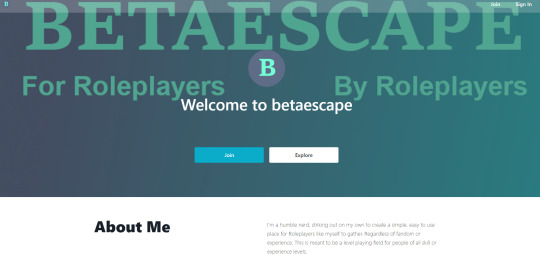



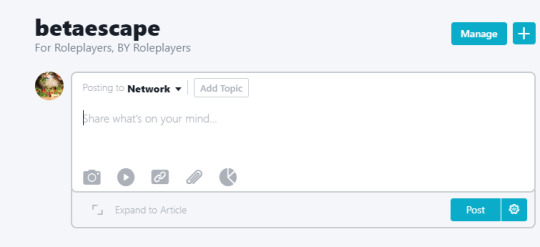


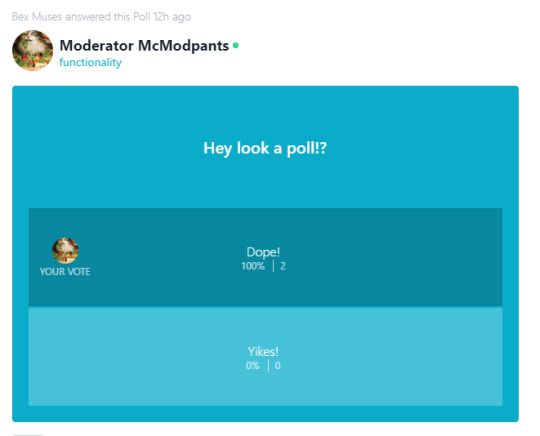

In the event that tumblr ignores the feedback about their beta as they have with everything else and they make that awful update a reality... I came up with my own solution for roleplaying and communicating with my friends outside tumblr without having to retreat fully to discord. It was made specifically for ROLEPLAYING. Since there are really no places where RPers are both welcome and catered to. All other social platforms are accessible to fandom groups but not as much to Roleplaying. Which is getting harder and harder on Tumblr with every update. So this site is for US.
It may be renamed in the future but for now it’s been affectionately dubbed
“BETAESCAPE”
It’s a site members can join to share photos, write short or long posts, reply to other folks, like posts and do all the basic social media functions. It’s a meat and potatoes platform that gives the members a functional website without having to subject themselves to having to move to facebook or twitter or going discord-only.
Pros:
It functions as intended
You can write "Quick posts” with no formatting and no character limit (that I’ve discovered) or you can write “articles” with as much formatting as you want.
Nested/threaded replies that you can add basic formatting to! And you can add pictures to your replies as well.
Members get a profile where you can have an avatar, a header and can write a brief bio/rules/muse list/whatever you like.
You can post pictures, videos and even attach FILES!
You can blacklist! And very easily! Instructions are provided on the moderator blog for how to do this.
You can instant message other members. Which includes being able to send files over IMs.
You can tag other members in posts with the @ function
It’s FREE TO JOIN. Some premium functions may cost money and may be lost without donations but creating an account (or multiple) will NEVER cost you a cent.
THERE’S AN APP! Just download the MIGHTY NETWORKS app through your app store and find “betaescape” to access all functions from your mobile device.
Cons:
It is unfortunately not what tumblr used to be. There is no “reblogging” to add comments. You cannot “share” a post at all. Tumblr had a very unique posting system that not many other sites have had and is difficult to recreate. This functions a bit more like Twitter but with the option to make bigger posts. (But if you like or reply to a post it will show up on your activity for your followers to see. So there will be a means to track your replies)
It’s VERY simplistic. No frills. It’s free and made by someone who is NOT a coder.
The premium features will run out without donations to help keep it running. I’m one person behind this whole thing and I have my own bills and expenses to pay for.
Image quick posts only allow one image at a time. You can post as many images as you like in an “article” but there are no “photoset” options. But that part of tumblr still works just fine for content creators who make edits. It’s the writing part that this site is intended for.
If you want to blacklist a topic, it must be a topic made by the HOST (me). Unfortunately it’s impossible to give members access to create their own ‘topics’. But if you want a topic to blacklist something, you can message me on that site and ask that I create a topic for people to use so you can blacklist. The standard tagging system isn’t what works on this site.
Premium features for members:
Squads- Members can create a “squad” for themselves and their friends. Squads can be public or private. So if you want to Roleplay with a select group of people, without the whole world seeing, you can have that privacy.
Polls- Ask any question and get your responses in a variety of ways
Events- Schedule events for your followers to attend. Online meetings, group chats, live streams, even face to face meetings if you want to schedule convention meet-ups.
These features are available free for 11 more days as of the creation of this post. (1/19/2020) then the free trial runs out and they will be lost. If members would like to keep these premium features, donations will help towards doing so. The link to donate is on the site landing page. But, again, donations are not required to create your account. Just if you want the extra added features.
Also if I get enough donations, the site can officially have its own domain name! Which it currently does not have.
I know a lot of people want to migrate to Pillowfort but currently they are still asking for money before people can make their account. And I know not everyone has the means to drop a minimum of $5 just to make an account on a currently incomplete site that... After testing doesn’t provide the environment needed for roleplay. No shade toward Pillowfort, it’s going to be a wonderful site someday and what they are doing is no small task... It’s just not what I’m looking for.
16 notes
·
View notes
Text
BBHMM, OR HOW TO DEAL WITH THE DEADBEAT CLIENT

You’re a fucking freelancin’ badass, with a semi-steady flow of work, and you’re living the dream of doing **insert best/fave thing here** , and getting the money from your biggest fans. Can’t be better, right?
Well, one of things you were probably not informed about is what happens when the dream sometimes becomes a financial nightmare. 30 day waits for payment. Invoices and reminders. Anxiety waiting for that check. Clients that don’t seem to care that you’re eating peanut butter for breakfast, lunch, and dinner while your payday is delayed in a death spiral of perpetuity.
Getting stiffed sucks, and you gotta keep the lights on. How can you keep this bullshit at a minimum?
I’m not a financial expert, but I’ve eaten a fair amount of shit trying to get money from clients that have a sense of urgency about everything except paying me. There’s a ton of info about this online, but hopefully my lewd voice in the choir is helpful. (Samuel L. Jackson voice) LET’S GET YOU YOUR MONEY, MUTHAFUCKA.
FROM THE BEGINNING

Make sure that you get everything down in writing. Have a statement of work or a contract that states your scope of work, your fee, deadlines, usage restrictions, deliverables, and any notes about late fees, payment timetables, and billable expenses. (Example of a statement of work).
Make sure that a client knows that you can’t begin work without acknowledging these terms. They should return a signed copy of this document, or acknowledge its terms via email. Sometimes there’s a rush situation and you may be pressured to dive in. It’s still a clients responsibility to make sure everything is taken care of on paper, to protect you and to ensure that they are also in the best position to get the best from you.
If they “politely” ignore the contract, then reiterate the terms in a follow up email, with a polite call to action (ex: “Hi! I’m just making sure that we’re on the same page about what the scope of this project is all about. I going to be [**rates, usage, time, deliverables, expected expenses, payment expectations here**]. Is that correct?). It’s important to get this down on the front end. Depending on your state, this counts as a legally binding statement.
NOTE: Try to get an upfront deposit if you can. 30-50% is normal, and this is also a test of whether the client will be good for it after all is said and done. This is also an incentive to put your best foot forward. Some clients will balk at this, but if the early “what is your rate?” convo suggests this is a possibility, go for it. This also depends on the industry. This is almost impossible with editorial, and though I’ve heard mixed stories in publishing, it’s hard to get an advance or deposit unless you’re doing a full book. Large corporations often have a convoluted accounts payable system that pretty much guarantees money will be slower than human evolution. The best results I’ve had are with small, dynamic businesses and individual clients.
Once they confirm the terms, then you can begin scheduling and first steps in a project.
FAST FORWARD TO PROJECT COMPLETION

INVOICE IMMEDIATELY. Seriously. Do NOT delay this. Most clients are not going to remind you to send one after you’ve finished a project, and you are ultimately responsible for this. (example invoice).
Include the basics:
your business name
your contact info and address
the client’s info and address
an invoice number
total due
Don’t forget an invoice number- accounts payable folks have a hard time placing your invoice in their system without one, and you don’t want to delay things because of a technicality. You can use a simple numbering convention: I use my initials and a double digit combo (ex: DD01).
Also, if you haven’t gotten an EIN, get one from the IRS. WHEN YOU APPLY, ONLY GO TO THE .GOV IRS LINK. SCAMS ARE A-PLENTY AND I WANT YOU TO AVOID TEARS THO. An EIN is great, because it can be very compromising to keep putting your SSN out there, and in some cases an EIN can get you paid faster.
You should itemize your work in the invoice, similarly to how you would find items on a receipt (ex: 1- Illustration for “client and application”, **brief description** = $THIS AMOUNT.00)
Write amounts in dollars and cents. Instead of “$3000”, write “$3000.00”. Again, this helps your client or client’s accountants process your payment a touch faster, and saved time counts.
Include a line with a total of your billable expenses. These are items that you HAD TO purchase to finish your work. Make sure you keep your receipts, and make a PDF slideshow with scans of those items for transparency’s sake. Send that PDF with your invoice.
Finally, include a line that is the grand total of EVERYTHING. Put that total in BOLD PRINT just to make sure that it’s clear what the client owes.
If necessary, you can include direct deposit info. This includes your routing and account number. This way, you give the client another way to pay you, and you can fight off the delay of waiting for a paper check.
Even though it’s assumed in many places, make it clear that payment is due NOW. From the moment you send the final invoice out, the onus is on the client to pay up. They should confirm receipt of this, but if they’re slow after a day or two, give them a quick email reminder.
NOTE: If you have a client’s phone number, keep it handy. This will come in handy later.
FAST FORWARD TO A FEW WEEKS LATER AND YOU HAVEN’T BEEN PAID YET

Either way, you’re waiting (and hopefully pursuing other work!) for money that you need.
The timeframe for a reminder varies. Some people will drop a friendly note after 15 days. I tend to be a bit generous, and will wait until 10 days before the invoice is late. The email is friendly, and assumes good faith. Something like:
“Hi! I just wanted to touch base about the payment for this invoice. Is there any progress on this? Is there anything I can do to assist with this? Please note that you will be 30 days late on (date here). If so, then a (late fee percentage) will be added to the final amount due.”
The key is to emphasize some kind of fiscal penalty. People don’t like to spend more money, so you’ll, at the very least, get a response to let you know that things are being processed. You may also get redirected to an accounting department. If you get a number or an email to them, HOLD ON TO THIS INFO.
Hopefully, at this point, the client gets the push to make good on payment.
FAST FORWARD TO 30 DAYS AND NO PAYMENT

At this point, you are apprehensive because no one wants to wait to be able to pay bills, eat pizza, and enjoy their own Netflix account. The dynamic changes now, because this is the day that the client has to pay you before it’s late. Tomorrow is late. In some states, you have legal recourse to pursue payment (In NYC, the default timetable for freelance payment is 30 days).
You should email your client reminding them that payment is due today. If you have their number, call them as well to reinforce this message, but emails are important now. Each email you send is a recorded effort to receive payment, and they are timestamped for posterity.
Note that a client may have already sent a payment out, but the check is transit. Also, calling/emailing an accounts payable department will reveal that a payment has been made and it will be in your bank account in a few business days. Get confirmation of this before you continue.
AFTER THE INVOICE IS 30 DAYS LATE

Clients need the benefit of the doubt, but it’s their responsibility to pay you now. After 30 days, you have “permission” to increase the frequency of your correspondence. During the first 10 days of being late, I will email and call every other business day (Monday, Wednesday, Friday was my model, but it may differ for you).
Afterwards, I will check in once a day. This may seem excessive, but persistence goes a long way. You may get an exasperated response, but don’t stop until you get a confirmation of payment or a layout and timeline of the payment.
If you have a contact within a company, use them as your ally within an organization. It’s easier to get things moving with someone on the inside, and pressure on them will translate to pressure elsewhere to get you to stop asking for your money.
Be professional, but direct. They owe you, and any further delay will result in additional fees, and possible collection action (including legal action to collect).
If you have a number for accounts payable, hammer them hard. They will be probably be your last line of communication, and you’ll need to get an email to reach them again, an employee name to refer to, and a timeline for payment.
SIDEBAR>>> NYC CREATIVE PROS AND THE FIFA ACT

If you live in NYC, you have an additional resource: the city government. The NYC Department of Consumer Affairs (DCA), and The Office of Labor Policy and Standards (OLPS) have a complaint form that you should fill out as soon as the client is over 30 days late.
The Freelance Isn’t Free Act (FIFA, passed in 2017) is very clear that what your client is doing is ILLEGAL, and the city will assist you in gathering materials to make a case for nonpayment. Fill the complaint form out, be very specific about your client and any related contacts. Note, they are not legal representation as much as they’re navigators who will help you find legal counsel and resources needed to file a claim in court.
Remember when I said to get everything in writing? That’s important. It may be a bit of work, but find every email thread related to your freelance gig. If you’re doing this on your mobile, open the thread. Go to the first message. Find where the “print” option is. You’ll be taken to a preview window. Look for the “download” button. This is really easy with Gmail. You can basically save the entire thread as an organized PDF, with messages in chronological order

Do this with every gig-related email attached to the overdue payment. Save these PDFs to a folder. Create sub folders that can put this correspondence in context, like chapters (ex: one folder is “Beginning of Job”, another “Job in Progress”, another “Invoice/Payment Requests”). This will make it easier to navigate everything.
Include the PDF folder (zipped) with your complaint folder. OLPS will take a sec to get back to you, since you’re not the only person in NYC that gets stiffed. After about 5 biz days, give them a call. This can help you get ahead of the pack.
You will receive a call from an OLPS office case manager who will confirm your info. They will ask if you’ve been paid. If yes, then you can thank them and call everything off. If not, they will send a certified letter (WITH AN OFFICIAL ASS LETTERHEAD) to your client, reminding them that they’re late. They have 20 days to respond to this- if they don’t, then they will basically be on the hook to go to court for a nonpayment case.
You’ll have to either get a lawyer to rep you, or you can rep yourself, but the client is on the hook to prove they don’t owe you. Since you already have a record of your interactions, this will be very difficult for them.
It should be noted that clients tend to get reallll antsy when the government says that they owe money. They’ll probably contact you directly. Keep up with these responses. Each email builds out the timeline of your case, and is fodder for the cannon. At this point, they usually pay up. DISCLOSURE: I’ve never had to go to court, so you may need to look elsewhere for advice. This may be a good place to start.
SPEAKING OF DOCUMENTATION- I forgot to add that you should record your calls when speaking to clients that are late. ACR is a free app that allows you to record your calls. Make sure recording is legal in your state, and always let clients know that the call is being recorded. You can borrow the “for quality control purposes” line if you’d like. Sometimes people will try to circumvent documentation by using the phone. Don’t let them weasel out of that.
LASTLY, this is specifically related to NY. The parts about documenting your correspondence are universal, though. Wherever you are, a vital part of making a civil case is piling on the material against a deadbeat. Be vigilant and persistent. I would suggest looking into whether there is a state govt. entity that you can go to about civil cases, and also look up if there are any local volunteer/low cost lawyers in your area.
The FIFA Act has been a gamechanger in giving freelancers more power to get what is owed to them, and my hope is that other cities follow suit, or organize to get similar legislation for this purpose.
SIDEBAR AGAIN>>> LAWYERS
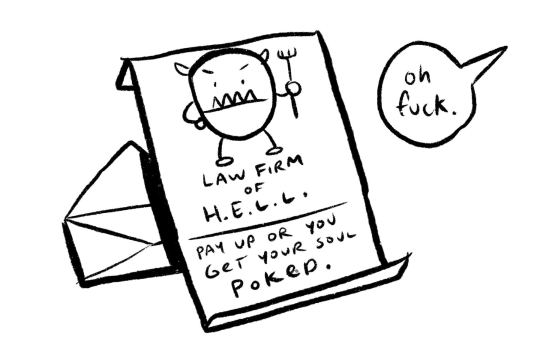
Another way to get a client to pay up faster is to lawyer up earlier. After 30 days, you should see what your options are. If you can afford it, you can consult with a lawyer and get a pro opinion about your case. They may be able to send a stern letter to your deadbeat client (WITH AN OFFICIAL ASS LETTERHEAD) prompting them to pay or else. Like with a government agency, people don’t like surprises from legal.
They will probably pay up quick, but if they stick it out, then you can file a claim and take them to civil court. This will be costly for you and your client, so nonpayment usually gets resolved before this happens. If not, know that if a court rules in your favor, the client will have to pay you and cover your legal fees.
My experience with lawyers is limited, and I would suggest looking elsewhere for particulars. Also, keep in mind how much you’re owed. A $300 case may not be worth as much squeeze as a $3000 or $30000 one. If it’s a low ball sum you’re owed. You may have an easier time calling it a loss and moving on.
EDIT: I’ve been told that contingency fee lawyers are out there that don’t collect fees until after an event (like you winning or losing a judgment for example), but they’re kinda like unicorns for freelancers and tend to take on bigger cases. It doesn’t hurt to see if any are out there anyway!
NEW!>>> COLLECTION AGENCIES
So, you may want to seek help through a collection agency. They have the time and resources to call, mail, and chase money when you’re trying to focus on good clients that pay on time and are depending on your A game.
The good news is that most are contingency fee based. That is, they won’t collect anything from you until they get the money from your client.
The down side? They can take anywhere between 18-40% of what your client’s debt is. Note that I didn’t say WHAT THEY COLLECT. If your client owes $100, and the contingency based fee is $30, an agency will take $30 even if they only get $60.
Also, based on a lawyer friend’s input, if your collection agency is legally shady, you may be indirectly on the line if your deadbeat client decides to sue said agency. Also your payment, connected to the collection agency and your client’s legal battle, will be held in indefinite limbo.
So do your homework and weigh your options before taking this route.
FAST FORWARD TO 60 DAYS
Fortunately, I haven’t had to do this, but you can start pursuing legal action to get your money. Check on state laws to make sure this is the case, as well as the particulars about filing a claim.
By this time, you should hopefully have a lawyer or some legal counsel at your disposal. If you don’t, then look up the laws of your state and local area to see where you stand if you have to rep yourself.
Remember that as long as you have written acknowledgment of your terms of work and written acknowledgment of your invoice, things should lean in your favor.
THE END
HOPEFULLY this has been helpful. The best parts of freelance (independence, flexibility, control, and self-prescribed wages) are often at odds with the pitfalls (feast-or-famine dynamics, wearing of all of the hats, taking all of the risks). It can feel like robbery when you put your blood, sweat, and tears into a project only to have an empty bank account as thanks. Some of this info is boilerplate, and some is from direct experience. If any of this relates to you, and you were able to get closer to your hard earned scrill because of this, I can die happy(er).

GOD SPEED AND GET PAID, GODDAMMIT!
ADDENDUM: One of the things that I didn’t emphasize enough is that doing this will be emotionally draining. Unless you are a robot or a stone cold Type A business beast, it will strain you. Make sure that you’re taking care of yourself mentally.
If you have a partner or family, make sure to take the help and support they provide and don’t turn your money issues into a personal issue with them.
Also, doing this requires energy. It will feel like a part time job, and even if there are late fees that factor into what you get paid, this will largely be unpaid labor.
Persistence is key, but I’m not going to pretend that it’s not hard or that you won’t have other obligations that make keeping up the effort difficult. I’m lucky in that my girlfriend and I have a relatively low-expense lifestyle, and no dependents, and we’re both fairly flexible because we both freelance full time, and that we had a bit of financial padding saved to weather the storm. Mileage will certainly vary.
Edit: Tumblr is weird about making links visible, so I put them in bold body font for you to find them easier.
570 notes
·
View notes
Note
Rose! How do you feel about Emma and its various adaptations?
Sorry for the delay in answering - blame the school trip!
I love Emma. I wrote my dissertation partly on it (also on Northanger Abbey, Rob Roy and St Ronan’s Well) and while I loved it before I loved it even more after studying it. All of Austen’s novels are extremely well plotted, but Emma might just be the best. It’s like a detective novel in that respect (and has been described as such on multiple occasions) because you can pick up on clues to what’s really going on all the way through but on a first read, you don’t see them. Miss Bates unintentionally reveals details that can be explained by Frank and Jane’s secret relationship but they are hidden in her verbal overloading. Emma’s own thoughts betray her unknown interest in Mr. Knightley, and his actions point to his love for Emma. And so on.
Jane Austen is also being radical in her use of literary conventions and genre in Emma (as she is in basically all her novels). She has the tightest mystery plot ever written at this point hidden directly inside a novel that sticks strictly to the conventions of romantic comedy. She even goes overboard with it - successfully navigating three couples to appropriate happy endings. However, within that solid structure, she plays with expectations and conventions in a subtle way and this is where I get really excited.
First we have Emma herself, a heroine “nobody but myself will like”. Austen clearly loved questioning and pushing conventions of who was allowed to be a heroine. Her previous novel, Mansfield Park, gave us Fanny who most people at the time found disappointing after Elizabeth Bennet and modern readers (unjustly IMO) hate, and she followed Emma with Anne Elliot who was far too old to be a romantic heroine according to contemporary standards. In the middle we have Emma Woodhouse, a meddling snob. She’s got a lot in common with Mr. Darcy actually and her character development in terms of recognising the bad behaviour she is guilty of and the prejudice she feels towards those of a lower social status is pretty similar. But while Darcy and his character development is held up as beautiful and heroic and romantic, Emma is frequently condemned as dislikable. I do wonder why that could be… Personally, I love Emma. She’s clever and shrewd and funny and, honestly, is there anyone who doesn’t think Miss Bates is annoying and doesn’t want to throw a tantrum at the prospect of being upstaged by Mrs. Elton? Are you, dear reader, such a paragon of rational enlightenment and charitable feeling? Would you instantly see through Frank Churchill and resist his flirtations? Would you be best friends with Jane Fairfax and not be just a little bit jealous of her and how much Mr. Knightley everyone seems to admire her? Have you never said something cutting and regretted it? Are you perfect, reader, ARE YOU? Come on. Emma is one of us. She messes up, she judges badly, she says cringeworthy stuff in inappropriate situations, she gives bad advice - she’s human. And she deals with it without losing her positive outlook and she does grow, enough to “deserve” her happy ending (though that’s a loaded concept) but not so much it’s unrealistic. And what makes her likeable through it all are that her intentions are good. Emma is not a bad person who has to become good and “be redeemed”. She is a fundamentally warm and caring person who needs to have some bad habits of thought and action corrected by guidance and experience. Emma’s intentions and understanding are good from the beginning.
Emma’s also interesting because, yes, she does change, but if you put her in the context of the genre she inhabits, she also gets to keep a lot. Basically, in another novel, Emma would have to pay significant penance for her bad behaviour before she would be allowed to marry Mr. Knightley and she would have to prove that she is a changed woman and is absolutely not going to continue meddling and will be a good and submissive wife. Usually this also involves giving up the dangerous reading of novels which have led her astray. Several points. Firstly, Emma is not a novel reader, she is a novel writer. Emma is described by various critics as “an avatar of Austen the author” and if you read the novel through the prism of Emma being an author, things become really fascinating. Beautiful, illegitimate Harriet Smith is the heroine of Emma’s novel and obviously Emma-as-author wants to discover that she is really the long lost daughter of Somebody and give her a socially advantageous marriage. Emma’s matchmaking attempts are the workings of a novelist plotting with characters. Emma is creating her own world. This is radical stuff, in a society where female novelists were looked down upon. Emma has the means and independence and cleverness to write a story of her own - and she is comically bad at it. This is one way in which Austen plays with genre. Secondly, it is not at all clear that Emma does give up her matchmaking at the end of the novel. Austen is coy when she floats this suggestion about Mrs. Weston’s daughter: “[Emma] would not acknowledge that it was with any view of making a match for her, hereafter, with either of Isabella’s sons”. Does this suggest that maybe Emma isn’t as cured as she should be? Thanks to Austen’s levels of irony it’s impossible to tell, which is the point. Thirdly, Emma is the only Austen heroine to have real financial and social clout. Emma really does rule Highbury and at the end of the novel, instead of being subsumed into her husband’s world, he in fact moves in with her (however temporarily). This is practically the Regency equivalent of her keeping her name after marriage. She and Mr. Knightley are social equals and she does not leave her home or her sphere of influence when she marries. The only other heroine this would be true of is, interestingly enough, Fanny Price. But Mansfield Park is notoriously inward looking and Fanny’s ending allows her to truly become a Bertram which is what she wanted all along for better or worse. And Fanny and Edmund’s social status and influence are much less significant that Knightley and Emma’s are.
Something else to bear in mind when thinking about Emma’s character is that, despite her social power and wealth, she also lives an extremely confined and limited life. She is essentially a carer for her stultifying and claustrophobic father. She has never left the environs of Highbury. She is surrounded by people who jump to her every command and shower her in praise, both deserved and undeserved. The only person who criticises her is also in love with her. The only eligible men in her world before the arrival of Frank Churchill are her brother-in-law who is 16 years older than her, and the obsequious vicar. Yes, she can remain a spinster but even a rich spinster cannot maintain the sort of power she currently holds when faced with a married woman like Mrs. Elton (who is a real threat to her), but her alternatives are bleak. A woman of her rank and fortune should be having a London season and meeting other young people of her rank and forming external connections. Because of her father’s passive control over her, Emma has none of these opportunities. Even Fanny Price travels more and meets more people than Emma does. Yes, Emma Woodhouse is handsome, rich and clever and has had very little to vex her, but I suspect that is probably Emma’s own view of her life and it is not necessarily accurate.
Okay, this post is already far too long so I’ll end my discussion of the novel here. There’s also a lot that could be said about Jane and Frank, Emma and Mr. Knightley’s relationship and more, but Emma is clearly the most important and, honestly, the most in need of defence!
Onto the adaptations, and I’ll try to be brief:
1. The Gwyneth Paltrow film. Jeremy Northan is divine though his hair could be better and he’s not my favourite Mr. Knightley, even if I do have a massive crush on JN. Harriet Smith is a not particularly attractive redhead which is… weird. Frank Churchill is Ewan McGregor but he has appalling hair so IDK what was going on there - such a missed opportunity. Gwyneth Paltrow as Emma is a casting disgrace and I honestly can’t bear to watch this film because every time she is on screen I cringe. The producers were more interested in the aesthetic than making a good adaptation. My grandma hated it. Enough said.
2. The Kate Beckinsale film. Honestly, I don’t dislike anything about this except that I wish it were a mini-series and the proposal scene is a bit… eh. But I think it manages to stay true to the book in a feature film and I love Kate Beckinsale’s Emma. She has the right mix of liveliness and arrogance for me. Mark Strong is a stern Mr. Knightley but he’s not too handsome. Frank Churchill is perfect in this adaptation. Controversially, this is my favourite period adaptation.
3. The Romola Garai miniseries. I love lots about this mainly because the length allows everything to be expanded suitably. Johnny Lee Miller is the best Knightley by far. The Eltons are fabulous. Frank and Jane’s relationship gets more time dedicated to it. The Westons and Bateses are great. Harriet Smith is dumbed down too much - she’s naive and not too bright but this adaptation makes her practically an idiot, almost as much a disservice as the 2005 P&P film’s character assassination of Bingley, though physically the actress is perfect and she’s very likeable. And I really do appreciate what they were trying to do with Emma. It was clearly an informed choice to make her bubbly and often silly and a chosen interpretation of the text and I respect that - better that than wilful misinterpretation which some adaptations go in for. I fundamentally disagree with it - whatever her faults, I don’t think Emma is silly and giggly and I struggle to believe this Emma is a 21 year old woman secure in her position as a social leader. Her mannerisms often come across very modern - her little waves, giggles and posture and this is very irritating because Romola Garai has done some fantastic period acting (Daniel Deronda, The Hour etc.) and these mannerisms aren’t consistent across the cast. I love Romola Garai and I think it’s an interesting choice of direction, but not one that rings true to how I see the character though.
4. Clueless. Clearly the best adaptation of Emma ever made. We all know it.
5. Emma Approved. Only seen a bit of it and didn’t warm to it. Should probably give it another go. Why did they change Knightley’s name to Alex? What the hell is wrong with George!?!?
Anyway, here are my thoughts on Emma. Hope they’re at least somewhat interesting. There is nothing I like better than rambling on about Jane Austen! :-) Thank you for giving me the opportunity!
99 notes
·
View notes
Text
Astrology And Its Impact On Human Life
-: Introduction of Astrology:-
From the beginning period of civilization an invisible factor, perception or rather to say a hidden point of view has always been there in the mind of the people on the life and lifestyle they have got in this world. At the first stage the question about this issue was hidden or rather sleeping inside the mind of the people but they that point of time neither they had any clue nor any answer, As long as time passes and development took place in civilization the question spread its impact drastically on the mind of the people of different stages, different backgrounds as well as from the different ages.
At that point in time, people observe that in that era, a few people were leading a life like a king and others were slaves to rich people. So quite naturally a question was haunt them why they are poor and leading such a disgraceful life? Or in spite of giving the same labor why some farmers were able to produce enough crops than the other, though both have given the same amount of labor? These types of still arise in our mind too, only the standard of the question has changed due to circumstances. The only major difference is that at that time they didn’t have any answers but now they do have an answer behind these circumstances, and the answer is “Astrology”.
Astrology is known to be an age-old subject that was first come up with India is a scientific calculation based on the celestial movement to a group of people or to a community and just a fake, unreal and impossible facts and measures to another group or community’s people. Several cultures, as well as countries, have taken and acknowledged the concepts of Astrology and implement them in the daily lives of common people. In the West, soothsaying frequently comprises an arrangement of horoscopes indicating to clarify parts of an individual's character and foresee future occasions throughout their life depends on the places of the sun, moon, and other divine articles at the hour of their introduction to the world. Most of the expert celestial prophets depend on such frameworks.
In today’s time, there are lots of options are available as part of Astrology and they do leave their footprint on the life of common people according to their fate. So lots of options are in hand as a part of Astrology such as Horoscope Reading, Palmistry, Face Reading, Tarot Card Reading, Chinese Horoscope Reading, Vedic Astrology, etc. These are all part of Astrology that has been invented and developed in a different part of the world in a different point of time.
Horoscope:- A horoscope is a prophetic outline or chart speaking to the places of the Sun, Moon, planets, mysterious perspectives and delicate edges at the hour of an occasion, for example, the snapshot of an individual's introduction to the world. The word horoscope is taken from Greek words hõra and scoops signifying "time" and "onlooker”. Other applicable names for the horoscope are a natal diagram, prophetic outline, astrograph, heavenly guide, sky-map, star-diagram, cosmogram, vita sphere, radical outline, radix, diagram wheel or basically diagram. It is utilized as a strategy for divination with respect to occasions identifying with the point in the time it speaks to, and it shapes the premise of the horoscopic conventions of soothsaying.
Palmistry:- Palmistry, is the situation of visualizing the future through the examination of the palm, generally called chirology, or in popular culture, as palm scrutinizing. The preparation is found wherever all through the world, with different social assortments. The people who practice chiromancy are overall called palmists, hand perusers, hand specialists, or chirologists.
Face Reading:- This is another form of Astrology which is not only famous in India but also all over the world. In this type of practice, every aspect of the face is being observed and analyzed to predict the behavior and characteristics of a particular person. Here every single detail of the face is being analyzed, for example, if the person’s eyes are small or big, the nose is sharp or blind like these types of details are being examined in this type of astrological study.
Tarot Card Reading:- Tarot card perusing is the act of utilizing tarot cards to pick up understanding into the past, present or future by detailing an inquiry, at that point drawing and deciphering cards. Perusing tarot cards is a kind of cartomancy.
-: Impact of Astrology on Human Being:-
Like everything Impact of Astrology has also two sides the good one and the bad one. As a good part of Astrology, we can say that by using it on daily human life most of the people are getting better results day by day. By using the tricks and techniques given by the Astrologer, Palmis or the Tarot Reader.
A large portion of people nowadays have chosen Astrology as their career option and choosing this the option they are doing good in their lives successfully.
Due to impressive development in this field, people are relating to this subject and its circumstances are inventing new facts and information and thus we are learning and gathering new knowledge on this subject.
As many people consider this as their employment thus this occupation helps a country to grow economically.
Just like that Astrology also impacts dangerously to a group of people or to a community, by making them nervous, tensed and lazy people in their lives. Due to the hard and unreal divination of the astrologers, people become scared of life and the challenges they need to carry away in this life as their duties.
A large part of youth those are not getting their dream job, love interest, or unlimited economic the success they are getting attached to this alternative named Astrology.
Thus to discuss on this topic we must admit that when it has some good impacts on our society it does have a bad impact on our society.
1 note
·
View note
Text
Have an idea for a future edition of TIFO? Hit reply and tell me.
View this email in your browser
Like this newsletter? You'll also likely enjoy our book: The Wise Book of Whys
(Print/Kindle | Nook | Audiobook) and our podcast: The BrainFood Show (iTunes | Google Play | Stitcher | RSS/XML )
Our latest episode of the podcast is up for your listening pleasure: How Porcupines Mate, the Bizarre Sex Habits of Giraffes and Much, Much More
What Happens if Parents Don't Give Their Kid a Name?
It turns out there are a shocking number of rules and regulations concerning what parents can name their children, when the naming has to happen by, and even a section of the United Nations Convention on the Rights of a Child that specifically states that all people, from birth, have an inalienable right to have a name. This all brings us around to the topic of today- what happens if parents flout that right and don't give their baby a name? And, further, what are some of the rules surrounding what names can be chosen in the first place?
To begin with, let's start with arguably the easiest to answer both of these questions- the United Kingdom. In this case, you have 42 days to name your baby, during which you can expect to occasionally be pestered by officials if you're taking your sweet time getting around to it. If you pass that time period, you will receive a £200 fine and, if you still refuse to give a name, a government official will name the child for you.
That said, in some cases UK officials may allow you to extend the period a bit beyond the 42 days, so long as you convince them a resolution seems reasonably close at hand, you pay the fine, and keep them notified of the progress. Further, UK parents have up to a year after birth to submit a correction to a name should there be an error in official documentation or if the parents just change their minds and want to re-name the child.
Beyond giving quite a lot of time for parents to pick a name, unlike a lot of countries on this side of the pond, the UK is also pretty lax about what names you can pick, generally having few guidelines other than it cannot contain obscenities, numbers, be impossible to pronounce, and must not contain a title that could be misleading. Should you choose to flout these rules and try to name your child SirOkkkxkxkxkuppppp Sh*tface Whistler, you can expect the Registering Officer to go ahead and reject all but the "Whistler" part of that.
In contrast, in countries like Norway and Denmark, you are required to pick from an approved list of names. In most countries that have such rules, including these two, you can attempt to deviate from the list if you go through the proper paperwork and approval process first. Failure to get prior approval for an unlisted name will usually result in some sort of fine and either the state rejecting the name submission outright or if it slips through, the child's name may be forcibly changed later. For example, in one case in 1995 a Norwegian woman, Kristi Larsen, attempted to name her 14th child "Gesher," which is Hebrew for "bridge." Kristi claims the name came to her in a dream. The state, however, didn't care about her nocturnal hallucinations, and fined her the equivalent of $420 (about $700 today). Unfortunately for her, when she refused to pay the fine, she was arrested and put in jail. She stated of this, "If we accept the fine, it's like we're admitting some kind of guilt." She further brazenly stated no matter what the courts say, "We're still calling Gesher, Gesher."
While not as strict as Norway, many other nations in Europe do similar things, with varying guidelines generally centered around trying to ensure the child is not given an outlandish or offensive name.
For example, in the early 2000s, a couple living in Germany attempted to name their child Osama Bin Laden, a man they seemingly admired a great deal. This broke two naming rules in Germany. First, this name was "likely to lead to humiliation" for the child. Second, it was against the rules in the couple's home country of Turkey as well, which also made it against the German rules.
Germany is also one of a surprising number of nations that require that the child's name indicate what gender they are. If it's unclear because it's a foreign name, generally the German officials will simply reach out to officials from other countries where the name is common, if any, for their input before approving or denying a name.
Another example of this is France where, while they have relaxed their rules significantly about the naming of children in recent years, you still cannot pick a name for a child which might be construed as the child being a different sex than the name is usually associated with, much to the chagrin of one French woman who tried to name her daughter "Liam".
Going back to what happens if parents don't name their child, Germany is also one of many, many countries where if you fail to choose a child's name after the allotted time period (in this case 4 weeks), an official at the Standesamt will simply choose for you.
In cases where the state picks, officials seemingly almost always just select one of the more popular names in a given country for a given sex of child- except in the United States, which, as ever, does things slightly differently.
To begin with, there is basically no standardization from state to state within the U.S. with regards to naming children, nor standard time period where this needs to occur. The few rules that do exist tend to be more practical in nature, for example often not allowing special characters simply because the state's database data type for the name field doesn't support them. There are also usually basic rules about how the last name should be chosen to facilitate dispute resolution should there be contention. For example, in Louisiana if the mother was unmarried 300 days before the birth (so slightly before conception in the vast majority of cases), the mother's maiden name will get precedence in a dispute, whereas if she was married at the time, the father's, unless both parents agree to something different or there is otherwise no dispute.
That said, as database systems are updated rules sometimes change. For example, after a software update, Illinois began allowing numbers to be put in names, or even the name itself to be a number, like "7", which is what at least one couple we found chose to use as the middle name for their son, no doubt after watching Seinfeld.
There are also states, such as Alabama, Kentucky, Washington state, and Montana, that don't even require the last name to match the parent's at all, able to be pretty much anything you want within the bounds of the few other aforementioned rules about character restrictions.
That said, a few states do include laws concerning use of offensive terms, such as California who not only extend this to the naming of babies, but also what you can change your own name to. For instance, in 1992 California courts barred a man from being able to change his own name to "Misteri N*gger"
Moving on to what happens if the baby is not named after whatever period (usually in the ballpark of a week to a few weeks, with some buffer period after for changes without additional fees or hassle), it turns out there is no official standard here either.
To start with, Michigan, Connecticut, and Nevada do not require a person to have a legal name at all (not even a last name) for their birth certificates to be processed. As far as we can find this has never caused a significant issue anywhere, other than in one court case where a Connecticut judge needing to clarify the rules here was completely flummoxed when he tried to look into the matter, stating, "The court has inquired of dozens of Connecticut lawyers and judges, and no one has supplied even a portion of an answer to the question: How is a person's legal name established?"
In general what seems to happen in these cases is that if the parents forgo naming their child within the allotted time before a birth certificate must be processed, no name is given and the parents are simply allowed to submit one later when they ultimately decide on one. That said, because of certain federal requirements such as when trying to get a Social Security card, Passport, etc., as well as when trying to register a child for school and things of this nature, for practical reasons a name will inevitably be officially submitted at some point, which is perhaps why it's not ever really an issue despite lack of official state rules.
Other states, like Ohio, simply require that at minimum a surname be given for the birth certificate to be processed and then, in Ohio's case, they give you a year to decide on the full name.
So what about the more general case in the United States where a name is required to process a birth certificate and the parents do not give one? Well, the baby will be given a name. However, unlike in many other nations where this name would be something common within the nation, in the U.S. the name given will almost always be something like "Baby Boy", "Male", "Baby Girl", "Female" or just "Baby" with an appropriate surname tacked on. In the case of twins, something like "Baby GirlA" and "Baby GirlB" or "Baby One" and "Baby Two" are also common. Exceptions do exist though for abandoned babies and the like, where occasionally officials will select a proper name for the child if a relative of the child can't be found willing to take them in and name them.
As to the more common case of indecisive parents, these "Baby Boy" style names are a result of what hospital staff use as a placeholder in the hospital database until the parents give the baby a name. If the parents then fail to ever give an official moniker, the placeholder name inevitably gets used in the birth certificate processing, which is also typically handled by hospital staff.
It should also be noted here that studies have shown this practice by hospitals of basically giving every child the same first name if the parents haven't provided one absolutely increases the odds of issues for the baby while in the hospital, usually in the form of mix ups with treatment and medication and the like, for example if there are two "Baby Boy Smiths" in the NICU at the same time. To help resolve this, admittedly rare, issue, some hospitals have switched to further tacking on the mother's name, so "JennifersBoy Smith" instead of "Baby Boy Smith". Of course, in more recent times this is even less likely to occur anyway thanks to commonly used wristbands with ID chips or barcodes to reduce the risk of screw ups anywhere, though they still happen.
To further simplify things on their end, some hospital workers will also attempt to pressure the parents into giving the child a name as quickly as possible, and even in some accounts we read actually tell the parents that it's required by law to give a name before the baby is allowed to be taken home. However, despite what any hospital official may tell you, in the United States, this is not required. Nor is it required that in home births the midwife or you give the baby a name right away, simply that you do report the birth to the appropriate state department.
Now, while you might think surely no parent would allow their child to be named something like "Baby Boy", it does happen occasionally. Not always about not caring or inability to agree on a name, however, some parents feel the child themselves should pick their own name, and because it's a fairly straightforward and relatively inexpensive process in the U.S. to change the name later, using the hospital's place holder name for official documents at first isn't usually a big deal.
Perhaps the most famous example of this is Olympic skier Picabo Street, whose name was originally Baby Girl. Picabo explains,
At first, my parents didn’t have a name for me. My name on my birth certificate... reads Baby Girl. And that’s what they called me until I was almost 4. When they planned our first train trip to Mexico for vacation, we needed passports. My father liked the sound of Picabo, an old Native American settlement an hour south. I also liked playing peekaboo with him. My mother and father agreed on Picabo.
(If you're wondering, supposedly Picabo meant "silver water".)
In any event, many countries likewise make it no big hurdle to change a child's name, usually just a bit of paperwork and a fee, so long as both parents agree or if one parent isn't in the picture this can be conclusively demonstrated first. That said, delaying doing so in the U.S. does potentially open things up to a judge's discretion on what might be acceptable, whereas naming from birth in the U.S. usually has few if any restrictions other than on character set.
Finally, we should probably mention that in 46 of the 50 states in the U.S., should your name be something silly like "Talula Does the Hula from Hawaii" (more on this one in a bit in the Bonus Facts), but everyone calls you "K" and you yourself accept that as your name, that is now legally your name if you want it to be. However, for certain official documents at the federal level, like passports, you still may need to get the courts to give you official documentation of the change. But outside of this, you are allowed to use your chosen name as your official, legal name even if it doesn't match what's on your birth certificate and you never went through any official process to get it changed. We're guessing little Adolf Hitler (another we'll get into in the Bonus Fact in a bit) is pretty thankful for this one, regardless of what his parent's political views are.
If you liked this article, you might also enjoy:
What Happens if you Renounce Your Citizenship But Don’t Belong to Another Country When You Do It?
What Happens When Someone DOES Object During a Wedding and Where Did This Practice Come From?
What Happens if You Accidentally Damage or Destroy a Priceless Work of Art in a Museum?
How Exactly Do You Prove You’re Alive if You’re Accidentally Declared Dead?
What Really Happens When Someone Enters the Witness Protection Program
Bonus Fact:
In countries with few regulations on what a parent can name their children, like the U.S. and the U.K., relative ease of changing a name is probably a good thing. For example, consider the case of Heath Campbell who has a whopping nine children by five different women. The New Jersey man has named every one of his kid's with a Nazi theme. For example, little Adolf Hitler Campbell, JoyceLynn Aryan Nation Campbell, and Eva Braun Campbell. Apparently for reasons completely unrelated to the names, the state has taken custody of every single one of Heath's kids away from him. For example, in the case of Eva Braun Campbell this occurred when the couple attempted to check out of the hospital. Said his then fiance Bethanie Zito when the Franklin County Children and Youth Service informed her they were taking the baby, "I started screaming. I got hysterical. I had just been checked out. I was breast-feeding my daughter for two days straight. I changed her. I had clothes on her."
Heath himself stated of this, "I'm not allowed to have children because I’m a Nazi... Jewish people came... and took my kids all over a name. I didn’t murder anybody. I didn’t hurt anybody. What crime did I do? Yes, I’m guilty of loving my children.... Society thinks the Germans and the Nazis are bad people when really we're not. We're family oriented..."
The state, on the other hand, says neither the names nor his political leanings have anything to do with their decision to take the children, but rather the lengthy history of violence and abuse in the household, which was first discovered when Heath attempted to have a birthday cake made with "Happy Birthday Adolf Hitler" made when his son was turning 6. Officials then investigated the household with the result being a couple of his former wives stating that Heath both frequently beat them and variously threatened to murder them, among other red flags authorities found.
Perhaps not doing himself any favors, in one custody dispute case in which he was attempting to get custody of his 18 month old son Heinrich Hons Campbell who was taken shortly after being born in 2011, while Heath did technically dress up for the hearing, it wasn't in a way that exactly endeared him to the authorities. Rather than wearing something like a suit and a tie, he showed up dressed in full Nazi military dress uniform, as well as sporting a Hitler-inspired moustache. His prominent tattoo that says "Kill Judes" probably didn't help either. (And yes, for those German speakers out there, it did indeed say "Judes" instead of "Juden".)
Moving on to something much more silly, but nonetheless still not appreciated by the child in question, in New Zealand parents named their daughter "Talula Does the Hula from Hawaii". When the girl was 9, the matter was brought to the attentions of the courts during a custody dispute. Up to this point, the girl had simply told everyone at school her name was "K" as she was extremely embarrassed by her name. The judge in the case, Rob Murfitt, ordered the state to temporarily take custody of the child, during which time the name was changed to something not publicly disclosed. Said Judge Murfitt,
The court is profoundly concerned about the very poor judgment that this child's parents have shown in choosing this name. It makes a fool of the child and sets her up with a social disability and handicap, unnecessarily...
Share Share
Tweet Tweet
Forward Forward
If you'd like to help keep this newsletter ad-free or just otherwise support it, please consider buying a copy of our book for yourself or someone you know. Thanks!!! The Wise Book of Whys
Print/Kindle | Nook | Audiobook
You might also enjoy our YouTube channel: Check It Out Here
Author: Daven Hiskey
You might have missed:
Who Started the Flat Earth Conspiracy Theory?
Did Blowing in Nintendo Cartridges Actually Do Anything?
Is It Actually Important for Someone to Stay Conscious When Seriously Injured?
Anne's Lesser Known Diary
Can You Get a Ticket for Riding a Horse While Intoxicated?
Copyright © 2019 Vacca Foeda Media, All rights reserved.
You opted in at http://www.todayifoundout.com, or you wouldn't get this email.
Our mailing address is:
Vacca Foeda Media
P.O. Box 1011
Gold Bar, WA 98251
Add us to your address book
Want to change how you receive these emails?
You can update your subscription preferences (e.g. change your Daily or Weekly edition preferences, update your email, etc.) or unsubscribe from this list
1 note
·
View note
Photo

JACOBIN MAGAZINE
In coverage of the midterms, we’ve heard a lot about the House, the Senate, governorships, and even ballot measures, but almost nothing about state legislatures. That may soon change, because the Democrats’ meager gains in this department will be crucial to stopping corporate America’s next strategy to further roll back the twentieth century.
The weekend before election day, a little-noticed article was run by the Associated Press, detailing plans by right-wing groups to push for a constitutional convention after the midterms to alter the United States’ founding document. This itself is nothing new: the Right has spent the past few decades pushing for just such a thing. But with a historically radical GOP in power, and with the Democratic takeover of the House frustrating right-wing congressional legislation for the foreseeable future, the next couple of years could well see the Right go all in on circumventing Congress entirely by simply rewriting the Constitution.
“Having a divided Congress may cause the proponents to feel even more committed to this idea,” says Michael Leachman, senior director of state fiscal research at the Center on Budget and Policy Priorities. “They might imagine that this is the only way they’re going to win the radical changes to the Constitution that they want.”
There’s good news and, obviously, bad news to this. The bad news is, this is a scary prospect that would not only be a disaster for any future left-wing project — a Bernie Sanders presidency, for example — but would severely hobble efforts to mitigate rapidly intensifying environmental collapse.
The good news is, it can be stopped.
But first let’s back up for a second. For the last few decades, the Right has been gradually setting the table to pass a particular constitutional amendment (more on the details below). The most familiar way of doing this is to get two-thirds of both houses of Congress to approve it, before convincing three-fourths of all state legislatures — or thirty-eight of them — to ratify it. Congress actually came perilously close to doing this in 1995, when the amendment in question failed by one vote in the Senate.
Now, with Democrats controlling the House and a thinning GOP majority in the Senate, this is a non-starter. But there is another way to pass an amendment: have two-thirds of all states, or thirty-four of them, adopt resolutions calling for a constitutional convention on just this issue.
The proposed measure is the fabled balanced budget amendment. While its exact mechanics differ depending on who writes the language — in some versions Congress is simply barred from raising the debt ceiling, other times a supermajority is required to do so — the basic idea is to make it extremely hard, if not impossible, for the federal government to spend more than it takes in.
It’s not hard to see why this measure would be disastrous. The strict spending limit would serve as a constant, ready-made pretext to slash social spending. It would debilitate any effort to forestall catastrophic climate change, such as through unprecedented, large-scale investment in infrastructure. And it would magnify the impact of economic crises by taking away the government’s ability to stabilize the economy through spending. According to a couple of different estimates, balancing the budget in the face of the Great Recession would have sent GDP plunging by 22 percentage points and doubled the unemployment rate to 18 percent.
But wait, you say. Couldn’t a future Democratic president use this to jack up taxes on the rich? The answer is, not if the Right crams through any other constitutional amendments, such as an abolition of the federal income tax or a ceiling on federal spending, making brutal spending cuts the only avenue for meeting this legal standard. The Koch-funded American Legislative Exchange Council, one of the right-wing groups most aggressively engaged in this fight, included wording that would open the door to such limits in its model legislation in 2016.
And that brings us to the other terrifying thing about an Article V convention, so-named after the constitutional provision that governs it: there’s a good chance it could see the entire Constitution rewritten amid an orgy of corporate spending and lobbying.
This might sound like an exaggeration, but consider that the last time a constitutional convention met was in 1787. Originally called to simply amend the Articles of Confederation that then served as the country’s supreme legal document, the convention decided to rewrite the whole thing instead. Far from “the greatest document ever written,” the 1787 constitution — “the Constitution” — was the product of mess of bickering, wheeling and dealing, and bitter compromise that initially barely passed, and some of whose authors doubted would survive more than a couple of decades.
Now imagine that already chaotic, rancorous process re-done, except with an army of lobbyists with bottomless wallets deployed to put their clients’ stamp on the process. Imagine every form of legalized bribery dangled in front of hapless delegates to ensure they vote in line with corporate America, from generous campaign donations to the prospect of cushy, well-paid corporate jobs just through the revolving door.
“Ethics and campaign finance rules don’t apply to these delegates,” says Jay Riestenberg, who manages Common Cause’s campaign work on this issue. “I think Article V will work similar to ALEC — corporations and legislatures sitting around the table as equals.”
“This would be the mother of all opportunities for powerful interests to change the country’s Constitution,” says Leachman.
(Continue Reading)
22 notes
·
View notes